PinotFile: 8.37 May 13, 2011
|
Kutch Wines: Following Your Pinot DreamWhen I first met Jamie Kutch at Kosta Browne Winery in May 2005, he was a greenhorn winemaker learning the craft at the side of Michael Browne who was fashioning his wines in a section of the caves at Freeman Winery in Sebastopol. Jamie’s story is a familiar yarn, played out many times in the last decade by currently successful winemakers such as George Levkoff (a former bond trader who is the owner and winemaker at George Wines), Thomas Rivers Brown (an English literature major at University of Virginia and now owner and winemaker at Rivers-Marie), and Thomas Houseman (a former professional modern dancer who is now the winemaker at Annie Amie in Oregon). These individuals are but a sampling of those who left behind a different life to pursue Pinot Noir winemaking. In early 2005, I received a curious e-mail from a PinotFile reader in New York who related to me that he had spent the better part of a week staying awake until 3:00 AM reading past issues. He went on to tell me he had learned an enormous amount about Pinot Noir and wouldn’t stop until he had read every issue. My ears perked up when he told me he was leaving his career on Wall Street to make Pinot Noir in the Russian River Valley. Jamie had lived his entire life in New York City. A Fordham graduate, he was working as a NASDAQ trader with Merrill Lynch, commuting daily to Manhattan on the Long Island Railroad. At a young age, he developed an interest in wine and for a few years even made wine in his small apartment with grapes shipped out from the West Coast. The more he read and tasted, the more his passion grew. His Pinot Noir epiphany came when a friend shared a glass of 1999 Domaine de la Romanee-Conti La Tache. He recalled it fondly, “It simply blew my mind.” In 2003, while at home after a day at work on Wall Street, he was surfing the eRobertParker Bulletin Board and fortuitously stumbled upon Andrew Vingiello. Andrew also worked for a Wall Street firm, but on the West Coast. He told Jamie he was mentoring under winemaker Brian Loring at night and making his first vintage of Pinot Noir under his new label, A.P. Vin. The two communicated by e-mail and eventually Andrew sent Jamie a barrel sample of his wine which impressed at a New York wine tasting along side other California Pinot Noirs. Jamie was now really hooked and realized that Andrew was living HIS dream. Both Brian and Andrew urged Jamie to experience harvest and “get his hands dirty.” He was reluctant to leave behind his cadre of family and friends in New York and his girlfriend of eight years. It just did not seem possible until he met Michael Browne. A few months after receiving the barrel sample of A.P. Vin Pinot Noir, Jamie landed a new job with a large investment bank. The work was boring and the other employees had a cutthroat attitude. The offer to move to California was becoming more appealing. One day, he was able to acquire some Kosta Browne Kanzler Vineyard Pinot Noir online from a fellow member of Robert Parker’s Board. Upon opening one of the bottles, he was smitten. He exclaimed, “This was the best California Pinot Noir I have ever tasted.” Jamie sent an e-mail to Michael Browne detailing his dream to make Pinot Noir and requesting an allocation of Kosta Browne’s limited release wine, “4 Barrel.” The wine was sold out, but Michael agreed to send him a bottle from his own stash along with a note which read in part, “My advice is to go for your dreams if it is at all possible, otherwise, you might regret it for the rest of your life. A man once told me, ‘The biggest regrets in life are not things that you did, but the things that you did not do.’ I think he was a wise man. As for living the dream, it is pretty cool to work with something that you are passionate about. Lots of hard work is involved, but it is worth it. My advice if you think this is your calling is to drop everything you are doing and sacrifice a few years to get where you want to be. That is what I did, and it is going in a very good direction. Another good example is Andrew at A.P. Vin. He went for it and now it is taking him for a ride.” Michael also offered to help make Jamie’s dream a reality. He told him he would mentor him in crafting 125 cases of Pinot Noir under Jamie’s own label. Flushed with excitement, Jamie immediately quit his job in New York City, talked his girlfriend, Kristen Green, who had a good job at a public relations firm in New York, into joining him, and moved to San Francisco. Under Michael Browne’s tutelage, Jamie, 30 years old at the time, produced a 2005 Russian River Valley Pinot Noir from Amber Ridge and Demeo vineyards under his new Kutch Wines label. When his wine chat friends on Robert Parker’s Board found out about his new venture, he immediately had a mailing list of over 400 customers. As I previously wrote in a feature titled, “Love Among the Must” (Volume 5, Issue 9), Jamie proposed to Kristen at Kosta Browne Winery during harvest. He hatched a plot to deliver her engagement ring to her on the sorting table. The plan was that Jamie would propose to Kristen after a helper sent the diamond ring down the hopper on the last bin of the day. Jamie was nervously sorting grapes from Koplen Vineyard next to Kristen, and recalled their discussion earlier in the day about the unusual items found while sorting grapes such as a band aid, tomato worms, picker’s knives, and eyeglasses. As the last fruit was dumped and the box containing the diamond ring dropped onto the table, Kristen reached for the box and after opening it, said, “Anyone want a box with a.......diamond ring in it?” It did not register right away with her and that was when Jamie grabbed the box from her hand, got down on one knee, and proposed. Her choking reply was, “Get the f#%$ out of here. She then said, “Yes!” and everyone began celebrating with Champagne. That evening, the newly committed couple cleaned up, traveled to Healdsburg and spent the night at the Healdsburg Hotel after dining at Dry Creek Kitchen, with, of course, a bottle of Kosta Browne Pinot Noir.
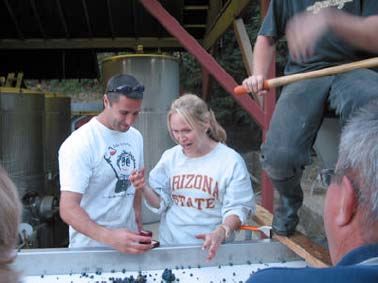
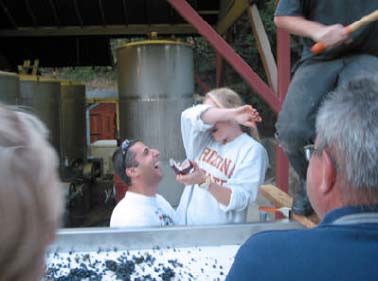 Jamie crafted two Pinot Noirs and a Pinot Noir Rosé from the 2006 vintage: a Sonoma Coast Rosé, a Russian River Valley appellation blend and a vineyard-designate from McDougall Ranch Vineyard in the Sonoma Coast. He moved his production base to Deerfield Ranch Winery in Sonoma Valley where Michael Browne first gained his winemaking experience under managing partner Robert Rex. Relying on his own resources and a loan from his father, Jamie became an independent producer with no investors or employees. It wasn’t long before James Laube of the Wine Spectator found Kutch wines on his radar, and considerable national publicity for the wines ensued. The first vintages were decent but not riveting to me and this was understandable as Jamie had no formal winemaking experience. He was a quick learner, however, and eagerly sought out the advice of many well-known Pinot Noir winemakers. In addition, he knew early on the importance of obtaining premium vineyard sources for his wines and sought out cool climate sites ideal for Pinot Noir. His dedication has paid off with the release of the stellar 2009 lineup of Kutch Pinot Noirs. Although Michael Browne was his first mentor, Jamie has quickly veered from the Kosta Browne style of Pinot Noir and developed his own approach that reflects the type of Pinot Noir he now prefers to drink. He has chosen Burgundy as his model, not trying to make Burgundy per se, but attempting “to resemble their fruit profile, ripeness level, intensity level, and acid and tannin levels.” Jamie has traveled to Burgundy three times and his experience has taught him “we aren’t that different.” He is consuming all the Burgundy he can get his hands on to enable himself to make vinification choices that more closely resemble Burgundy. His ultimate goal is food-friendly Pinot Noir that is also age worthy. Jamie prefers to pick earlier, striving for phenolic maturity at lower Brix and resulting alcohol, and seeking more acidity. He uses some whole cluster in select bottlings to provide structure and age ability. Fermentations are done using indigenous yeast with minimal acid adjustments and no addition of color enhancing agents. All punch downs are done by hand. All ferments are in small lots and only free-run juice is used for Kutch wines. The wines are aged in 4-year air-dried, tight-grain Francois Frères oak barrels sur lie for about 18 months, and racked only when ready to bottle. The wines are unfined and unfiltered. The resulting Pinot Noirs are moderately rich with ripe flavors and commendable balance and charm. The 2009 Anderson Valley and Sonoma Coast appellation blends are forward and ready for consumption now, while the single vineyard Pinot Noirs, although approachable now with decanting, need a few years in the cellar for full enjoyment, and have the potential for significant aging. I can heartily recommend the entire lineup. Jamie has called his 2009 wines “my best vintage ever,” and the McDougall Ranch Pinot Noir “the greatest wine I have ever produced.” Jamie goes on to say, “The McDougall Ranch Pinot Noir should easily see it’s 25th birthday!” Jamie noted that Domaine Dujac’s winemaker, Jeremy Seysses, tasted the 2009 McDougall Ranch Pinot Noir and remarked on Twitter, “09 Kutch: One of the more exciting US pinots I’ve had in a long time. Nice tannins, going places. Real sense of direction.” The Falstaff and McDougall bottlings are slated for a fall 2011 release. The Falstaff and Savoy bottlings are the first from Kutch. In his own words, here are Jamie’s key points regarding his approach to winemaking and winegrowing. “My belief is that my wines are fresher and drier because I use judicious amounts of stem inclusion in my wines. After exploring and tasting hundreds of old California and Oregon Pinot Noirs from the 1960s, 1970s and 1980s, I concluded that the freshest wines were those produced with some whole cluster, either by straight addition or from a violent de-stemmer that was outdated and left large amounts of stems and jacks in the must. I think the tannins from the stems act as a shell that forms around the fruit flavors, protecting and guarding them and allowing for longer age ability. When the tannins finally resolve, the remaining fruit appears fresher than if the fruit had been completely de-stemmed exposing it to degradation from the beginning. I also realized that vignerons in Burgundy used high levels of whole cluster during ripe vintages such as 1999, 2002, 2003 and 2005, and low amounts of whole cluster in lesser ones such as 2001, 2004 and 2007. In California, the fruit is nearly always ripe to over ripe so it makes sense to use stems judiciously in almost every vintage. After experimenting with the use of whole cluster, I found that the additional tannin levels would cover up and dry some of the fruity, sweet characters which are inevitable from the high levels of sunlight in California. In my first two vintages (2005 and 2006), I de-stemmed 100% of the grapes, and the wines came across as having that unappealing sweetness and dullness which, for my taste, all too often is a fault of New World Pinot Noir.” Jamie continued. “Picking early is important to achieve low levels of alcohol in the finished wine as high levels of alcohol give a perception of sweetness even it the wine is 100% dry. By carefully managing water and crop levels in the vineyard and minimizing irrigation toward the end of the growing cycle, the phenolics become ripe naturally at lower sugar levels. It is imperative the stem be void of water when picking to prevent any green sap from the cut of the stem to leach into the must during fermentation. This will lead to herbaceous characters. Having observed believers of long hang time in California water one day ahead of a heat spike to hydrate the vine and thereby lower sugar and acid levels and allow the plant to prolong phenolic ripening, I decided to change my approach. I found there is no need to prolong the growing cycle in California vineyards. I have discovered that my wines taste fresher by avoiding excessive and inappropriate watering, and the flavors ‘pop’ earlier when there is still plenty of natural acidity in the grape and sugar levels are low. By hanging the fruit and extending growth, purity, freshness and brightness can be lost, replaced by characters in the wine which are not to my liking.” 95% of Kutch wines are sold directly through a mailing list at www.kutchwines.com. 917-270-8180. Total production is 1,250 cases, with 800 cases of press wine bulked out to maintain quality of the wines offered. Jamie does not offer the wines for tasting at large Pinot Noir events, believing that serious appreciation of the wines is not possible under these circumstances. Smaller tastings are offered, such as one recently held at the Ferry Plaza Wine Merchant in early May.
2009 Kutch Anderson Valley Pinot Noir 13.8% alc., 264 cases, $39. Sourced from Deer Meadow Vineyard. Clones 114, 115, 777 grown organically. Yield 1.5 tons per acre. 100% de-stemmed, native fermentations, aged 18 months sur lie in 30% new French oak barrels. Unfined and unfiltered. · Moderately dark reddishpurple hue in the glass. Forward and effusive aromas of black cherries and wild berries initially, that fade a bit over time in the glass. Delicious core of vivid black cherry, black raspberry, and spiced plum fruit with restrained oak and tannins, offering a pleasing, but short finish. A very forward drinking wine that is a credible representation of Anderson Valley Pinot Noir. Good (+).
2009 Kutch Sonoma Coast Pinot Noir 13.9% alc., 288 cases, $39. Sourced from Sonoma Stage, Nobles and La Jons vineyards and includes a diversity of suitcase clones. 100% de-stemmed, native fermentations, aged 18 months sur lie in 30% new French oak barrels. Unfined and unfiltered. · Moderately dark reddish-purple color in the glass. A pleasing melange of berry aromas with a hint of oak. Tasty mix of red and black berry fruit with complimentary spice. Soft in the mouth with a healthy tannic backbone and restrained oak influences. Lacks nuance and acid zing, but provides a solid drinking experience. Good.
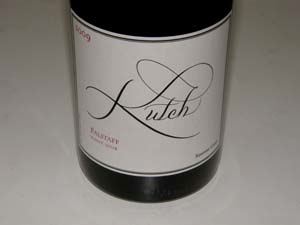 2009 Kutch Falstaff Vineyard Sonoma Coast Pinot Noir 13.1% alc., 168 cases, $48. Heirloom clones grown biodynamically. Yield .75 ton per acre. 20% whole cluster, native fermentations, aged sur lie 18 months in 50% new French oak barrels. Unfined and unfiltered. · Moderately dark reddish-purple color in the glass. Complex nose offering scents of black cherries, plums, spices including clove, and a curious note of prickly pear. This impressive wine offers a vivid and generous core of dark red and black berries and cherries with supporting smoky oak, and appealing spice and loamy earth notes. The fruit is front and center but the wine’s appeal is augmented by a very silky mouth feel, restrained but firm tannins, and bright acidity on an explosive finish which seems to last for 30 seconds. The wine drank nicely the following day from a previously opened and re-corked bottle. Needs several years in the cellar for full enjoyment. Very good.
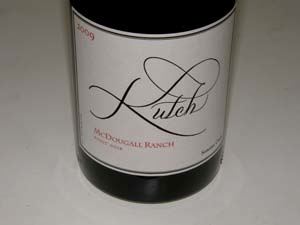 2009 Kutch McDougall Ranch Sonoma Coast Pinot Noir 13.9% alc., 288 cases, $48. Clone 114 planted in 1998 at 935 feet elevation, two ridges in from the Pacific Ocean. Yield 1.8 tons per acre. 50% whole cluster, native fermentations, aged 18 months in 50% new French oak barrels. Unfined and unfiltered. · Moderately deep reddish-purple color in the glass. The nose opens over time in the glass offering a lovely mix of scents of darker raspberries and cherries, spice, underbrush and even violets. A delicious and hearty mixed berry core is enhanced by notes of spice and cured meat. The fruit is largely buried by the imposing, ripe tannins but this should resolve with several years in the bottle. This wine has the most tannin in the Kutch lineup, but also possesses the most seductive fruit. The wine offers an unmistakable sense of terroir. Still fine, but closed, the following day from a previously opened and re-corked bottle. Don’t even think about drinking this connoisseur's wine for seven to ten years.
 2009 Kutch Savoy Vineyard Anderson Valley Pinot Noir 13.8% alc., 264 cases, $48. Clones 667, 777, 114 and Pommard. 100% destemmed, native fermentations, aged 18 months sur lie in 100% neutral French oak barrels. Unfined and unfiltered. · Moderately dark reddish-purple color in the glass. Subdued aromas of black fruits, forest floor, vanilla and graham. A silky body of earthy, spicy boysenberry and plum brings the mid palate to attention. Impressive persistence of fruit flavors on the generous finish. Beautifully balanced with lively acidity, ripe tannins and moderately rich fruit flavors acting in harmony. The pedigree of the fruit really comes through. Still great the next day from a previously opened and re-corked bottle. Will definitely benefit from a few years in the cellar, but can be approached now with decanting. A wine to contemplate.
Note: Jamie related this harrowing story in his latest newsletter. “Careening down a mountain with six tons of Pinot Noir strapped in the bed of a truck would certainly test the mettle of most winemakers, but rarely does it threaten life, limb, and most importantly, livelihood. At 10:00 A.M. on September 7, 2009, I would climb into that exact truck which was loaded to the gills with 12 bins of Pinot Noir fruit freshly harvested from McDougall Ranch. I was carefully shepherding this precious cargo back to the winery along windy Sonoma Coast mountain roads when, as I approached Meyers Grade, I noticed a sign that read, “20% Grade Ahead Trucks Use Low Gear.” For a split second, I considered my priorities. If the brakes were to fail, should I ditch approximately $30,000 worth of Pinot Noir fruit and jump out of the truck or should I risk possible physical harm to save what looked like the greatest fruit I had ever harvested? Moments later, this question would become all too real when I pumped the brakes not only once but twice, then three times and nothing. Fortunately, I was able to maintain control of the truck and guided it safely down the mountain in low gear. I finally rolled to a stop at the bottom of the Grade with my prized Pinot Noir fruit safe and sound.”
Sinor-LaVallee Wines: California Dreamin’The Sinor-LaVallee wines are a world apart from those of Kutch which were reviewed in the previous article. Although owner Mike Sinor uses the Burgundy model of finding specific rows of vineyards with world class terroir, and contracting for those rows to make site-specific wines, and, like Kutch, has traveled to France and studied the vineyards and wineries of Burgundy, Mike’s Sinor-LaVallee wines are California in style through and through. As Mike notes, “In the cellar we like to take chances and occasionally push the envelope, which is the only way we know how to produce memorable wines.” The Pinot Noirs are macho, with robust, concentrated, and succulent flavors, moderately high alcohols, yet are engaging, evocative, and friendly in the mouth. Sinor-Lavallee was founded in 1997 by Mike Sinor and Cheri LaVallee Sinor in 1997. They first met as students at Cal Poly San Luis Obispo in 1993, and were married in Beaune, in the heart of Burgundy in 1996. The Sinor-LaVallee labels feature the thumbprints of family members. On the front label, Mike’s is on the right and Cheri’s is on the left. The fingerprints of children Tomas and Esmée are on the back label.
 Mike began his wine career while searching for a way to pay for college in 1991. He worked at Corbett Canyon Vineyards, located near to Cal Poly, and soon added several Edna Valley wineries to his employment resume. You probably remember those infamous Corbett Canyon commercials of the past featuring the echo, “Canyon, canyon, canyon.” Corbett Canyon, founded in 1978, was one of the first wineries in the Edna Valley, but has changed ownership several times through the years. Today, it is owned by Rob Rossi, and is a custom crush facility (SLO Winemaker’s Studio) where Sinor produces his Sinor-LaVallee wines. During the 1993 vintage, Mike took a leave from school to work full-time at Saucelito Canyon Winery. After graduating from Cal Poly in 1994, he joined Byron Vineyard and Winery and quickly became winemaker Ken Brown’s assistant. Mike left Byron after the 2000 harvest to assume the role of winemaker at Domaine Alfred Winery in San Luis Obispo. At Domaine Alfred he also supervised the biodynamic farming of 130 acres of vineyards. After producing five vintages of highly rated Pinot Noir and Chardonnay at Domaine Alfred, he departed to concentrate full time on his two projects: Sinor-LaVallee (Pinot Noir and Syrah) and Ancient Peaks (wines from Margarita Vineyard near Paso Robles and Corbett Vineyard in Edna Valley including Sauvignon Blanc, Cabernet Sauvignon, Malbec, Merlot, Petit Verdot and Zinfandel). Mike is one of the founding board members of the World of Pinot Noir held each year in Shell Beach, California. He is ever present at this prestigious event, but not always easily recognizable, sometimes sporting long hair and a beard, and other times close shaven with short hair. You never know what you will see at harvest, as Mike takes on a different persona each year and has been known to even sport a mohawk haircut. Four Pinot Noirs are now released under the Sinor-LaVallee label: a San Luis Obispo Central Coast blend, vineyard designates from Talley-Rincon and Aubaine vineyards, and a special Anniversary Cuvée. A small amount of Syrah from Luna Matta Vineyard is also produced. The wines are sold online through the winery’s store, through a mailing list at www.sinorlavallee.com, and limited retail distribution. Total production is about 500 cases. There is something for everyone in this lineup from the forward drinking San Luis Obispo bottling to the complex and haunting Anniversary Cuvée with years of life ahead. Prices are sensible.
2008 Sinor-LaVallee Luna Matta Vineyard Paso Robles Syrah 14.9% alc., 98 cases, $25. Sourced from 1 acre of this vineyard planted to clone 174. Mike emphasizes that the power in this wine comes from leanness and structure without overt jammy fruit that is often found in Paso Robles Syrah. · Deep, dark purple color in the glass. Lovely perfume of fresh blackberries, black currants, dried plums and oak cask. Layered flavors of plum sauce, dark berries, anise and sassafras. A big-boned wine with a prodigious tannic backbone and an intensely fruity ending that finishes dry and clean. Very good.
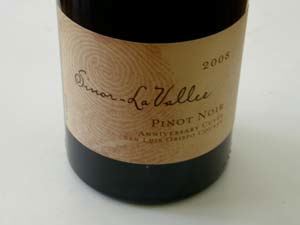 2008 Sinor-LaVallee San Luis Obispo County Central Coast Pinot Noir 14.0% alc., 133 cases, $29. Vineyard sources vary from year to year as Mike searches for the next vineyard designate. · Moderate reddish-purple hue in the glass. Explosive aromas of cherries, strawberries, cola and cardamom spice. Very tasty core of dark red cherries and berries with subtle oak, cola, chocolate and spice in the background. Lighter in intensity than the other 2008 Sinor-LaVallee Pinot Noirs, but thoroughly satisfying. With supple tannins and impeccable balance, this wine makes a terrific daily drinker and one to buy by the case. Very good.
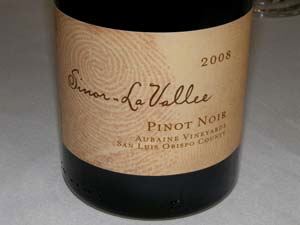 2008 Sinor-LaVallee Aubaine Vineyard San Luis Obispo County Pinot Noir 14.9% alc., 148 cases, $40. This 14-acre vineyard is located just off Highway 101 between the towns of Arroyo Grande and Nipomo. Clones 667 and 777. · Moderately dark reddish-purple color in the glass. Scent of moss, crushed rock, earth, oak and cut flowers, with modest fruit aroma. Intense and powerful flavors of red and black fruits with hints of anise, prune and grilled mushrooms. Nicely corralled and not as rugged and daunting as this vineyard is prone to be, with well proportioned tannins and a lengthy finish. Picks up interest and charm over time in the glass. A distinctive and unusual bottling that abounds with character and is very site-specific. Very good.
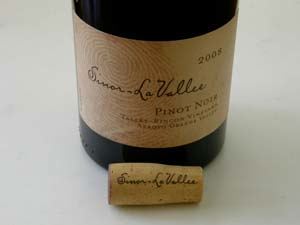 2008 Sinor-LaVallee Talley-Rincon Vineyard Arroyo Grande Valley Pinot Noir 14.8% alc., 73 cases, $40. From a 1-acre block consisting of 14 rows planted to clone 2A. Yield was .73 tons per acre. · Dark reddish-purple color in the glass. Aromas of black fruits, toasted oak and bark. Intense and savory flavors of very ripe dark fruit including spiced black plums and black currants. The fruit is clothed in firm but slippery tannins and there is well-honed balancing acidity. Soft in the mouth and relatively suave, but rather fruit-driven and linear at this stage. May deliver more nuance with time in the bottle. Good.
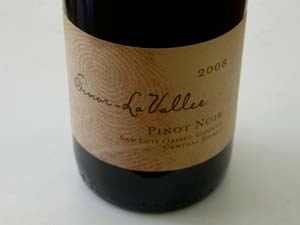 2008 Sinor-LaVallee Anniversary Cuvée San Luis Obispo County Pinot Noir 14.3% alc., 49 cases, $50. This bottling celebrates Mike and Cheri’s marriage in Burgundy in 1996 and is 100% whole cluster. The wine combines Talley-Rincon and Aubaine fruit. Mike calls it his “wild child,” because it is made with indigenous yeast fermentation and natural MLF. Only produced in vintages that warrant it. · The lightest in color in the lineup, sporting a moderate ruby-red hue. Lovely aromas of fresh strawberries, raspberries and exotic woods. More red-fruited and elegant than the vineyard designates, yet packed with flavorful delicately spiced red berry flavor. Seamless, with plenty of sparkle and spirit and a memorable finish with impressive length. Still very appealing the following day from a previously opened and re-corked bottle. About as perfect as it gets.
Le Cadeau Vineyard: A Rocky SituationTom and Deb Mortimer are transplants from Minnesota who acquired a never-before-cultivated 28-acre hillside property on the southern tip of Parrett Mountain in the Dundee Hills near Newberg, Oregon in 1996. A 17-acre, moderately high elevation (610’-725’) vineyard was developed and planted with a singular focus on growing distinctive estate Le Cadeau Pinot Noir. Le Cadeau translates as “the gift” in French. The vineyard is known as the rockiest vineyard in Oregon. It took a team of track-hoes, D-8 Cats, and tractors more than two years just to clear the raw land. Tom, who is a Burgundy freak, feels the effort and cost was well worth it. The advantage of planting Pinot Noir vines in this rocky volcanic soil is that this soil type promotes drainage, regulates temperatures of the vines, and reduces vine vigor. The result is small fruit clusters with tiny berries that potentially can lead to rich, fragrant wines.
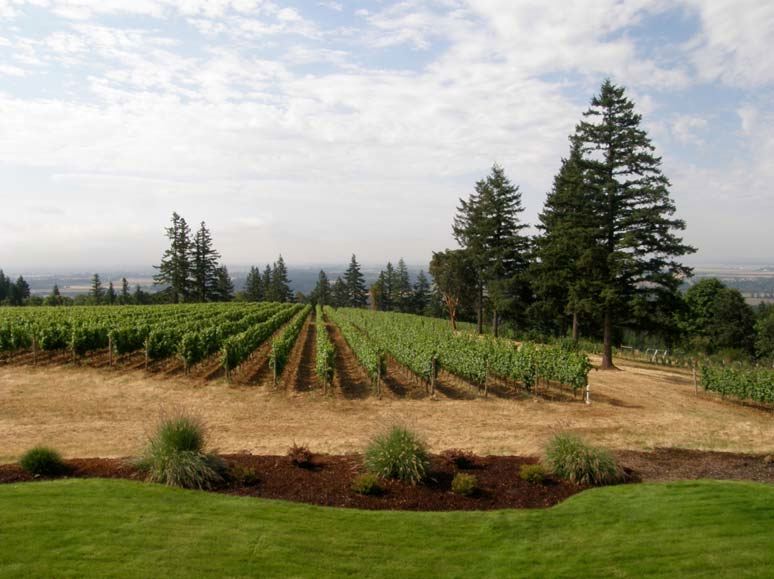
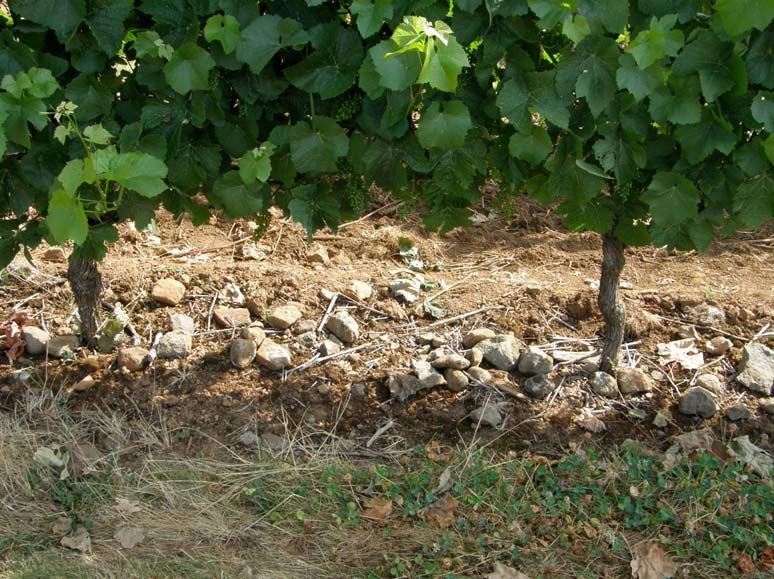
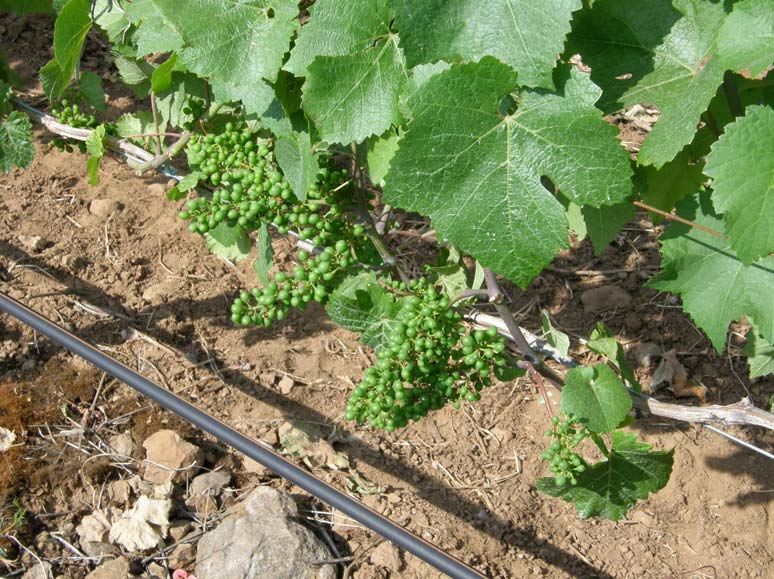
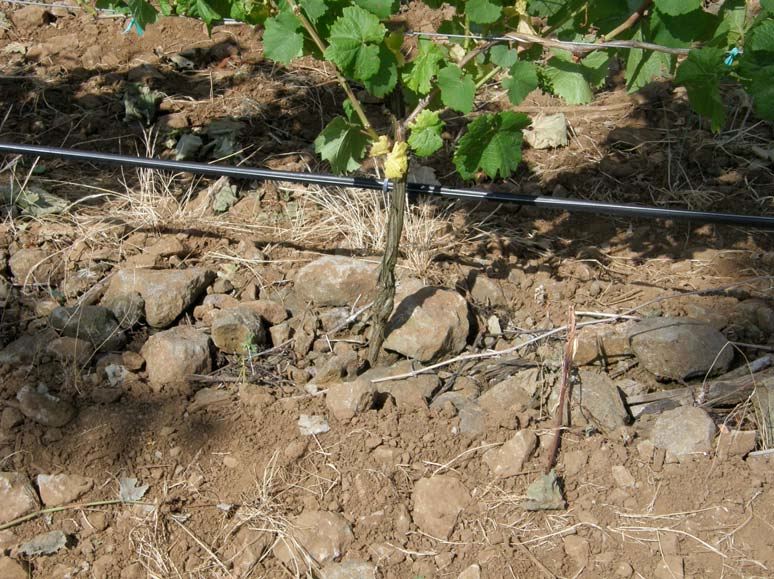 I visited the Mortimers at Le Cadeau Vineyard after the 2010 International Pinot Noir Celebration. They related their story to me. The first 6 acres of Pinot Noir were planted in the spring of 1999: 1.75 acres each of Pommard and Dijon 667 and 777, and .75 acres of Mariafeld, Pommard and 777, 113 and 115 in another east-facing area of the property. This .75-acre site became a rootstock test site, planted with different clones on various rootstocks. By 2000, viticulturist Buddy Beck, who had worked at Domaine Drouhin Oregon for many years, and his associate, Angel Martinez, took over the vineyard management and remain in charge today. The project turned out to be very expensive and was dubbed “The Black Hole Vineyard” by Deb Mortimer. The first wine from the property came in 2002 and was released in 2005, eight years and four months after purchase of the property. Encouraged by the character of this wine, an additional 4 acres of Pinot Noir, clones 114 and 115, were added bringing total vineyard acreage to 10 acres. 1,200 cases of Pinot Noir followed in 2006, but critical acclaim spurred on further planting. An additional 5 acres was planted that year, consisting of several additions to existing plantings using various clones including 114, 777, 667 and Pommard. 1.5 acres were added in the fall of 2008, including heritage clones such as certified Swan clone, likely the first certified Swan clone (UCD 97) to be planted in Oregon. Some inter-planting has been done as well. As I walked the vineyard, I was overwhelmed by the dizzying number of rootstocks, clones, spacing, and exposures. One thing was consistent: rocks were visible on the surface everywhere. The entire 17-acre vineyard (1 acre of which is on neighboring property but is farmed by Mortimer) will be in full production by 2012 and it is expected that Le Cadeau will be producing just over 2,000 cases of Pinot Noir annually. Noted viticulturist, Daniel Roberts, has consulted in recent years and there has been a concerted emphasis on shoot positioning. Tom made an unusual decision at the onset to use several consulting winemakers for each of the Le Cadeau Pinot Noir cuvées and the wines are vinified at each of the winemaker’s respective facilities. A complete listing of winemakers by cuvée is on the web site. I personally do not agree with this approach as it is difficult to get your arms around the five different cuvées representing different parts of the vineyard, different clones, and various winemaking styles, whose character varies considerably. The result is a puzzling array of wines without a Le Cadeau signature that can be recognized by most consumers and even connoisseurs. For the 2008 vintage, the wines include Côte Est (winemaker Steve Ryan, a former winemaker at Martinelli in California and now located in Hopland), Diversité (winemaker Scott Shull of Raptor Ridge), Équinoxe (winemaker Jim Sanders who trained under Mike Etzel at Beaux Freres), Rocheux (winemaker Jacqueline Yoakim of Keller Estate in California), and Serendipity (winemaker Tony Rynders, formerly of Domaine Serene for 10 years). For 2009, a Red Label Le Cadeau Vineyard Pinot Noir is crafted by Jim Sanders and is offered as an earlier drinking wine at a lower price point. Le Cadeau wines may be ordered through the winery’s online store at www.lecadeauvineyard.com. There is some retail distribution nationwide as well. The website is highly informative. Visits to the vineyard are by appointment only. The Mortimers are very gracious hosts. I tasted through several Le Cadeau bottlings during my visit with Tom and Deb Mortimer. Tom feels the wines take at least four years after bottling for maximum enjoyment.
2004 Le Cadeau Vineyard Rocheaux Oregon Pinot Noir The grapes were picked relatively early and the wine shows a lean minerality and tobacco flavor as a result. There are some leather aromas and pleasing cherry and strawberry flavors. Decent.
2005 Le Cadeau Vineyard Diversité Oregon Pinot Noir Vinified by Sam Tannahill. · Soft and smooth in the mouth with supple tannins and appealing herb and mineral imbued flavors of red cherries. Has the balance to age further. Good (+).
2006 Le Cadeau Côte Est Oregon Pinot Noir Vinified by Josh Bergstrom (2004-2006 vintages). · Great nose with effusive aromas of marionberries. Delicious ripe and sweet tasting berry fruit wrapped in supple tannins and finishing on a high note with refreshing acidity. Very good.
2008 Le Cadeau Serendipity Oregon Pinot Noir 14.1% alc., 68 cases. · Vinified by Tony Rynders. Demure, but pleasing aromas of dark red cherries and berries with a hint of spice. Well-spiced array of dark red fruits with a touch of savory herbs on the palate with bright acidity on the finish. Very good (+).
2008 Le Cadeau Équinoxe Oregon Pinot Noir 50 cases. Vinified by Jim Sanders. · A beautiful wine with shy dark fruit aromas and intense dark fruit flavors. Still evolving with the structural backbone and acidity to last. Good (+).
2008 Aubicon Cellars Reserve Oregon Pinot Noir Beginning in 2007, Tom Mortimer and Jim Sanders sourced from hillside vineyards farmed by Buddy Beck and produced about 300 cases of an Aubichon Reserve Pinot Noir ($42) and Aubichon Willamette Valley Pinot Noir ($34). · Adequate, but simple and homogenous fruit flavors, finishing with a little alcoholic heat. A daily drinker. Decent.
The following three wines were tasted in my usual fashion at home. I hope to re-taste them in another year or two to see how they evolve.
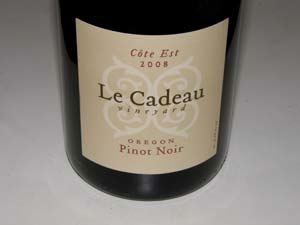 2008 Le Cadeau Côte Est Oregon Pinot Noir 13.9% alc., 351 cases, $48. From the cooler east side of the property where fruit is shaded from morning sun by neighbor’s trees. Winemaker Steve Ryan. · Moderately dark reddish-purple color in the glass. The nose lacks fruit, offering scents of pine, oak, spice and cut flowers. The black raspberry and black cherry flavors have an earthy underpinning and a slight vegetal note. Smooth on the palate with a short finish. Tasted the next day from a previously opened and re-corked bottle, the wine still was rather closed with slightly more fruit showing on the nose and on the palate. Hard to judge this wine currently which showed much better 9 months ago when tasted at the vineyard. Like many Oregon Pinot Noirs from 2008, patience is advised. Good.
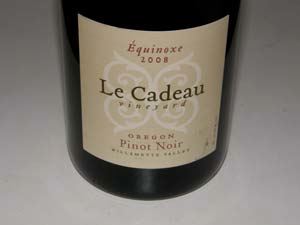 2008 Le Cadeau Vineyard Équinoxe Oregon Pinot Noir 14.1% alc., 196 cases, $48. Winemaker Jim Sanders. Sourced from the crest of the hill where the vines receive equal sun on both sides during the day. · Very shy nose with hints of cassis and oak. Crisp and tasty with a moderately rich core of dark berry and plum fruit supported by spice. Sporting notable tannins, this wine needs more time for integration, but shows potential. Good (+).
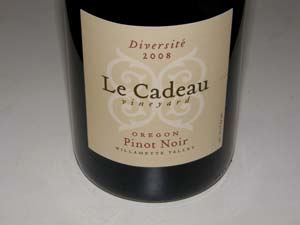 2008 Le Cadeau Vineyard Diversité Oregon Pinot Noir 14.1% alc., 270 cases, $48. From varied clones planted throughout the vineyard. · The aromas and flavors of this wine are buried in oak with coffee being the most prominent feature. Big-boned darker fruits are featured with flamboyant tannins. Tasted the next day from a previously opened and re-corked bottle, the wine tasted like a coffee drink. Time in the cellar should moderate the oak and allow the fruit to emerge, but this will always be an oaky wine. Decent at best currently.
California Pinot With Plenty of NoirThe following group of producers are offering releases from the 2007, 2008 and 2009 vintages that are easy to recommend. Alysian Gary Farrell has been crafting wines in the Russian River Valley since the early 1980s, starting his own eponymous label in 1982. He was to sell his label and Westside Road winery to Allied Domecq in 2004. The winery then passed through several corporate hands, including most recently in 2011, The Vincraft Group. Farrell left his eponymous winery in 2006 and partnered with Bill Hambrecht to found Alysian Wines. The latest venture, promises “no compromise” Chardonnay and Pinot Noir from Russian River Valley sources. The inaugural releases were from the 2007 vintage. A 2008 Starr Ridge Vineyard Chardonnay will be reviewed in a separate part of this newsletter. The 2008 vintage marks a return to a more elegant style of wines for Gary Farrell. He notes in his latest newsletter, “Many consumers and winemakers are beginning to favor a more elegant and refined style of wines. It is not that we seek less flavor, texture or depth, it’s simply that we understand abundance and generosity in wine is achievable without excessive extract and alcohol.” If he wasn’t so modest, he could have remarked that this stylistic goal is something he has sought after and achieved for nearly 30 years. The two wines reviewed here are the best yet from Alysian. My only nit with the Alysian wines is the ridiculously heavy bottles that don’t fit into my wine cellar racking. Alysian wines are sold through a mailing list at www.alysianwines.com.
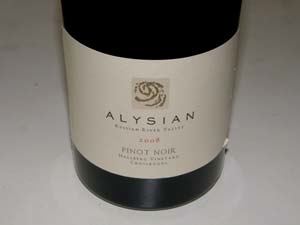 2008 Alysian Hallberg Vineyard Crossroads Russian River Valley Pinot Noir 14.2% alc., 160 cases, pH 3.46, TA 0.67, $55. · Moderate reddish-purple color in the glass. Really impressive fruity nose offering vibrant aromas of ripe cherries and strawberries with hints of graham, BBQ and sandalwood. Mid-weight essence of fresh cherries and strawberries with a subtle nutty note in the background from oak. Dry, fine-grain tannins provide support for this pretty wine that exudes charm. Very Russian River Valley in character, a more restrained interpretation of this vineyard source, and a wine of exemplary pinotosity.
2008 Alysian Starr Ridge Vineyard East Terrace Russian River Valley Pinot Noir 14.2% alc., 157 cases, pH 3.43, TA 0.69, $55. · Moderate reddish-purple color in the glass. Darkly fruited with aromas of graham and spice. Black cherry, black raspberry and strawberry flavors with the slightest hint of oak show up in a moderately rich format with restrained tannins, brisk acidity and a refreshing, slightly brambly finish. The silky soft composure is appealing. Much better the next day from a previously opened and re-corked bottle, when my wife and I finished the bottle over dinner.
Auteur Owner and winemaker Kenneth Juhasz produces small lots of Pinot Noir from California (Manchester Ridge and Sonoma Stage vineyards) and Oregon (Hyland and Shea vineyards) as well as Chardonnay (Durell, Hyde Donum and Hanzell vineyards in various vintages) in Santa Rosa, California. The word, Auteur, translates as “author.” Juhasz has a background of over sixteen years in winemaking in California, Oregon and New Zealand. Along with Auteur, Juhasz consults with several wineries, including Donum Estate, Pali Wine Company and Semper. Auteur was launched ten years ago and with the 2009 vintage has revised the label and logo to create a more sophisticated package. I find the change welcoming. Auteur wines are sold through a mailing list at www.auteurwines.com. Spring releases, in addition to the wines reviewed below, include a 2009 Sonoma Coast Pinot Noir, 2009 Durrell Vineyard Chardonnay, and 2009 Sonoma Valley Chardonnay (Hanzell Vineyard).
2009 Auteur Ophelia Willamette Valley Pinot Noir 14.6% alc., 91 cases, $38. Originally a blend of California and Oregon Pinot Noir grapes, but now a singular Willamette Valley blend. Four barrels from Shea Vineyard that did not fit into the Shea and Shea Back Block bottlings for 2009. Aged in 100% neutral French oak. · Moderately dark reddish-purple hue in the glass. Very ripe fruit profile with aromas of spiced black cherries and black raspberries and baking chocolate. Moderately intense flavors on the mid palate featuring dark cherries and berries with some spice and oak underpinnings. The tannins are restrained and the wine offers early drinkability. A little heat shows up on the finish. Good.
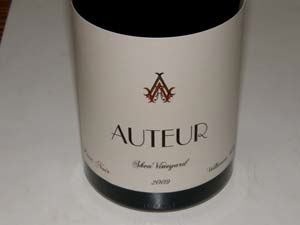 2009 Auteur Shea Vineyard Willamette Valley Pinot Noir 14.6% alc., 195 cases, $60. 90% de-stemmed, 10-day cold soak, minimal cap manipulation, 7- day post fermentation maceration, aged in new and 1-year-old barrels. · Moderately deep reddish-purple color in the glass. Subdued nose, picking up interest with time in the glass to reveal aromas of dark berry jam, dark chocolate and well-perfumed flowers. Tasty melange of blue and black berry fruits with subtle oak highlights and a lively acid grip on the finish. Picks up intensity with time in the glass. The fruit is obviously classy, but nothing stands out at this stage. Still very good the following day from a previously opened and re-corked bottle. Not as approachable as many 2009 Oregon Pinot Noirs, this wine will benefit from more cellaring. Very good (+).
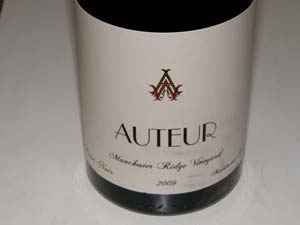 2009 Auteur Manchester Ridge Mendocino Ridge Pinot Noir 14.2% alc., 182 cases, $50. Clones 115 and 777 co-fermented. Yield about 2 tons per acre. 20% whole cluster. Aged 16 months in 50% new French oak barrels. · Moderately deep reddish-purple color in the glass. Demure, but seductive perfume of fresh black raspberries, black cherries, spice and vanilla wafers. Perfectly composed and seamless with delicious flavors of berries and bright cherries accented by notes of cola, baking spices and mocha, wrapped in silky tannins. Plenty of vim and vigor with impressive persistence on the long finish. Still great the next day from a previously opened and re-corked bottle predicting a long life ahead. I have had several stunning wines from this vineyard. One of my All-Americans for 2011.
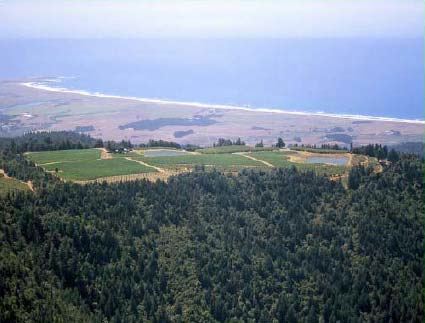
Carmel Road Carmel Road Winery is part of the Jackson Family Wines group and was founded in 1997. Located in Monterey County, Carmel Road has access to a large group of vineyards in the Salinas Valley including Rincon, Hacienda and Clark Ranch, and employs a mix of proprietary and traditional Burgundian winemaking techniques to produce Pinot Noir, Pinot Gris, Riesling and Chardonnay wines of consistently solid value. Winemaker Ivan Giotenov has more than 110 unique lots from which to create his final blends. The wines can be purchased online at www.carmelroad.com. A search may find the wines in retail wine stores discounted below retail price.
 2009 Carmel Road Monterey Pinot Noir 14.0% alc., pH 3.73, TA 0.54, 44,255 cases, $20. Released October 2010. Aged 9 months in 17% new French oak barrels, 3% new American oak barrels and 1% stainless steel tanks (1% Chardonnay in blend). Sourced from Panorama, Porter, Clark, Mission Peak and Mission Trails vineyards. · Moderate reddish-purple color in the glass. Nicely perfumed with an array of fresh berries. Brisk and juicy with a middle-weighted core of cherry and berry fruits, with a hint of cola, oak and citrus in the background. Soft with silky tannins. A solid daily drinker at a reasonable price. Good.
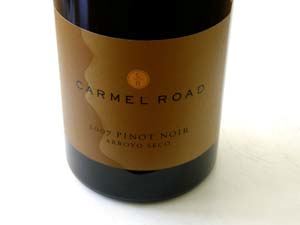 2007 Carmel Road Arroyo Seco Clark Ranch Pinot Noir 14.5% alc., pH 3.75, TA 0.54, 626 cases, $35. Clones 2A, 115, 667 and 777. The Clark Ranch lies in the shadow of the Santa Lucia Mountains. Most of this 1,100-acre vineyard is planted to Chardonnay with 34 acres dedicated to Pinot Noir. This limited bottling comes from a special, 4-acre block at the heart of the ranch that consistently yields a deep and compelling Pinot Noir. Cold pre-soak, native yeast fermentation, hand punch downs, and no fining or filtration. Aged 10 months in 39% new French oak barrels. · Moderately dark reddish-purple color in the glass. Enticing aromas of dark raspberries and blackberries, black cherries, kirsch, brioche and oak. Discreetly concentrated flavors of chocolate-covered, perfectly ripe cherries, and fresh blackberry jam. The vivid fruit is nicely caressed by fine-grain tannins, the oak is beautifully integrated, and there is impressive aromatic persistence on the fruit-filled finish. Very good.
Drew Family Cellars Jason Drew and his wife Molly founded the Drew label while Jason was an associate winemaker at Babcock Vineyards & Winery in 2000. In 2002, Jason left Babcock to concentrate on his own label. The Drews acquired a 26-acre ridge top property in the Mendocino Ridge appellation that was once a noted apple orchard. A winery and home was built on the property and vineyard land was cleared among the apple trees with the intention of future plantings of Pinot Noir. Pinot Noir grapes have been sourced from the Anderson Valley (Fog Eater, Savoy Vineyard, Monument Tree Vineyard), the Sonoma Coast (McDougall Ranch Vineyard), Mendocino Ridge (Valenti Vineyard, Perli Vineyard, Mendocino Ridge Vineyard), and the Yorkville Highlands (Weir Vineyard). Vineyard sources have been in flux due to vineyard ownership changes and grape availability that have ensued over recent years. Production of Pinot Noir (and Syrah) is 1,800 cases annually. Jason is a talented young winemaker whose wines have caught me eye for several years. The wines are sold on the website, through a mailing list at www.drewwines.com, and through limited retail distribution. A tasting room is located at 9000 Highway 128 in Philo, just northwest of the Goldeneye Winery (open Thursday thru Monday from 11:00 to 5:00). Molly Drew is pictured below at harvest. Both wines reviewed below were recently released.
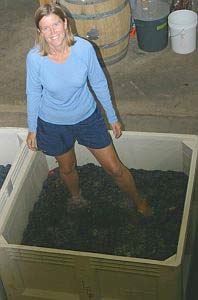
2009 Drew The Gatekeeper Blend Mendocino Ridge Pinot Noir 14.2% alc., pH 3.62, TA 0.67, 450 cases, $28. Released February 2011. 60% Perli Vineyard and 40% Mendocino Ridge Vineyard. Clones 114, 115, 777, 667. 100% de-stemmed. Aged 11 months in neutral French oak barrels. · Pleasant and complex array of aromas including red and black berries, black currants, raisin, cedar and savory herbs. Slightly tart flavors of cherry skins, pomegranates, and black raspberries with a savory bent. Crisp with restrained dry tannins. Easily approachable now. Better the next day from a previously opened and re-corked bottle. Good (+).
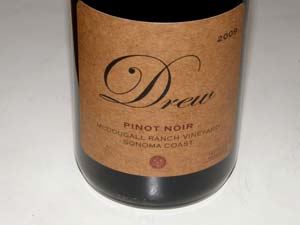 2009 Drew McDougall Ranch Vineyard Sonoma Coast Pinot Noir 13.7% alc., 183 cases, pH 3.65,TA 0.64, $47. Released March 2011. A 7-acre vineyard on a rocky outcropping at 935 feet elevation about 2.4 miles from the Pacific Ocean in the true Sonoma Coast. Fifth vintage from this site. Soil is sandy clay over bedrock. Clone 114. 30% whole cluster fermentation. Aged 11 months in 30% new French oak barrels. · Deeply and intensely perfumed with scents of wild berries, spice and cedar closet. Luscious core of blackberry, boysenberry, and black cherry flavors wrapped in flamboyant tannins. Fruit is perfectly ripe and has an exotic, animale quality. Amazing persistence on the big finish. Great potential. Better the next day from a previously opened and re-corked bottle.
Freestone Vineyards A top notch producer of West County Chardonnay and Pinot Noir owned by Joseph Phelps. The estate consists of a large winery in Freestone, and three vineyards: Pastorale, Quarter Moon and Ferguson. The Director of Winemaking is Phelps veteran Damien Parker, the Winemaker is Theresa Heredia, and the consulting winemaker is Burgundian Pascal Marchand. Fogdog Pinot Noir is a blend of grapes from the estate vineyards, approachable early, and reasonably priced. The Freestone Sonoma Coast Pinot Noir is a premium bottling of grapes from the estate vineyards. The wines are distributed to fine restaurants and sold through the tasting room in Freestone, the website at www.freestonevineyards.com, and the winery’s wine club, the Freestone Private Collection. I have had some remarkable wines from this producer.
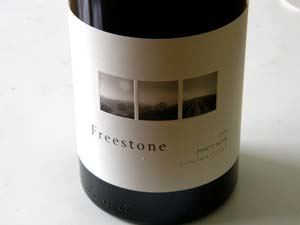 2008 Freestone Sonoma Coast Pinot Noir 14.0% alc., 3,900 cases, $55. 100% estate-grown from Pastorale and Quarter Moon vineyards. Aged 14 months in 60% new and 40% 2 to 3-year-old French oak barrels. · Moderate reddish-purple color in the glass. Lovely aromas of black cherries, exotic spice, brier and cut flowers with a slight hint of tobacco smoke, picking up interest and intensity over time in the glass. Black cherry-driven flavors with pleasing oak and whole cluster spice, slightly dwarfed at this stage by oak. Like cherry pie day at cooking school - cherries, baking spices and very interesting results. A solid wine that will improve in the cellar due to its impeccable structure. Very good (+).
Hirsch Vineyards David Hirsch was one of the first visionaries to plant Pinot Noir on the true Sonoma Coast and now farms 68 acres of Pinot Noir and 4 acres of Chardonnay. The first two acres date to 1980. A winery was built on the property in 2002. Hirsch supplies fruit to many prominent California wineries including Failla, LIOCO, Littorai, Siduri and Williams Selyem, and bottles both Pinot Noir and Chardonnay under the Hirsch Vineyards label. The current winemaker is Ross Cobb. The wines are sold by a mailing list at www.hirschvineyards.com and through limited retail distribution. The Hirsch Vineyard Estate bottling is named San Andreas beginning with the 2007 vintage, a reference to the location of the vineyard on a seismic fault that lies between Hirsch Vineyards and the Pacific Ocean (the prime cause of the property’s geology and topography).
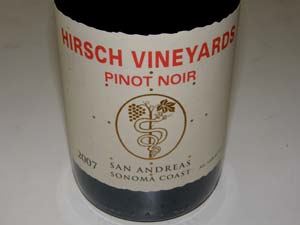 2007 Hirsch Vineyards San Andreas Sonoma Coast Pinot Noir 14.0% alc., $60. · Moderately light reddish-purple color in the glass. Very lovely aromas of a wild berry mix with accents of spice and oak. Wow! A mid weight core of dark red cherries and berries coats the mouth, uplifted with bright acidity that leads to a refreshingly juicy finish. A seamless wine lover’s wine with charming elegance that should age gracefully.
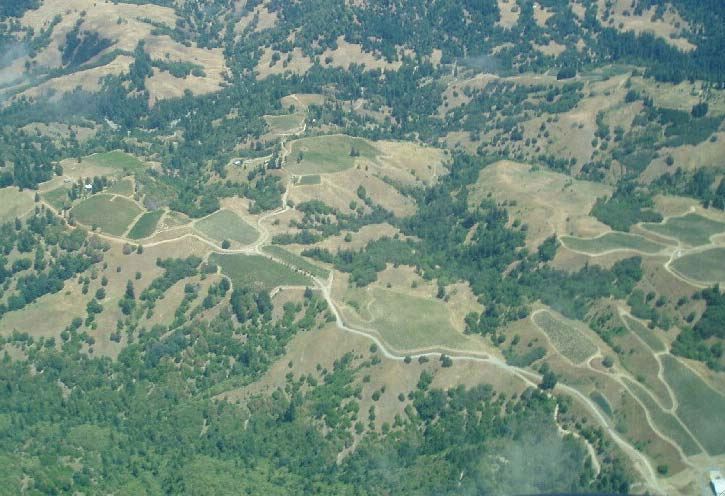
Presqu’ile Presqu’ile (“press-KEEL”) is a small new winery launched with the 2009 vintage. Located in the Santa Maria Valley, the winery is owned by the Murphy family whose gathering place on the Gulf Coast was named Presqu’ile, Creole for “almost an island.” The Murphy family have partnered in farming, forestry, oil and gas, and conservation for four generations. Today, two generations of Murphys joined with winemaker Dieter Cronjie and vineyard manager Jim Stollberg, to produce Presqu’ile wines. The estate is located between the Pacific Ocean and the San Rafael Mountains near Solomon Hills Vineyard and consists of 73 acres of certified sustainably farmed vineyards on a 200-acre property. Production centers on Pinot Noir, Syrah, Chardonnay and Sauvignon Blanc from the estate vineyard and from top growers in Santa Barbara County. The stylistic goal is to pick at relatively low Brix, producing wines of moderately low alcohol. The wines are fermented exclusively with native yeast and most wines are barrel-aged in 75% neutral French oak barrels. A stunning winery and tasting room is slated for completion in 2012. The wines are sold online at www.presquilewine.com and through retail channels. This is an up and coming producer with great promise as the estate vineyard plantings take on some age.
2009 Presqu’ile Santa Maria Valley Pinot Noir 13.7% alc., $42. 35% whole cluster, native yeast primary fermentation and native malolactic conversion. 56% Presqu’ile Vineyard and 44% Solomon Hills Vineyard. Clones 667, 115, Pommard and 777. Aged 14 months in 20% new French oak barrels. · Moderately dark reddish-purple color in the glass. Shy aromatics revealing demure scent of kirsch and mixed berries. Simple and direct flavors of black cherries and berries with a hint of spice, lively acidity and moderate fine-grain tannins. A good daily drinker. Decent.
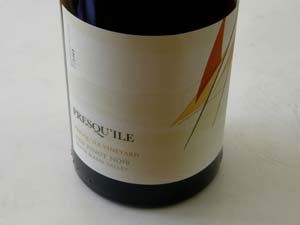 2009 Presqu’ile Presqu’ile Vineyard Santa Maria Valley Pinot Noir 13.7% alc., 350 cases, $Unreleased. Best 12 barrels. 40% whole cluster. Native yeast fermentation and native malolactic conversion. Aged 14 months in 50% new French oak barrels. · Moderate reddish-purple hue in the glass. Demure aromas of dark red fruits, spice and subtle oak. Tasty array of dark red berries and cherries with well-proportioned supporting t n’ a. Soft and smooth like the hair of an angel. Much better the next day from a previously opened and re-corked bottle showing plenty of signature Santa Maria spice. Needs a little more time in bottle. Very good.
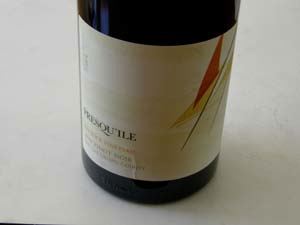 2009 Presqu’ile Rim Rock Vineyard San Luis Obispo County Pinot Noir 13.7% alc., 150 cases,$Unreleased. Only winery to receive grapes from this vineyard which is located 8 miles inland in southern San Luis Obispo County. 2 acres of own-rooted Dijon clones 667 and 115. Rocky soils and cool climate limit yields to less than 2 tons per acre. · Moderate reddish-purple color in the glass. Starts off strong with vibrant aromas of dark stone fruits, fading some in the glass as oak and green notes take over. The most intense, and showing the most fruit impact in the mid palate of the three wines reviewed here. Soft and smooth with notable tannin and oak presence, finishing with some persistence. Picks up appeal over time in the glass. A little disjointed now and will benefit from a year or two in the cellar. Good (+).
Red Car Wine Company A winery originally launched in 2000 by two Los Angelino wine lovers, Mark Estrin and Carroll Kemp. The style and theme of the wines have changed dramatically over the years, with Kemp carrying on the management and contributing to the winemaking after Estrin passed away in 2005. The focus of the winery now single vineyard Pinot Noir from the true Sonoma Coast where Red Car planted the Red Car Estate Vineyard in 2005 and sources fruit from other top notch cool sites. The wines have become less bold (the first Red Car Pinot Noirs were fashioned like Syrah) and more site specific with better balance and more nuance. Carroll emphasizes the importance of tension in wine: the coexistence of alcohol, acid, tannin and fruit in harmony. The website (www.redcarwine.com), newsletter and labels are among the best in the business. Second labels, which are value priced, include Boxcar and Trolley which complement the reserve single-vineyard Pinot Noirs. The reserve wines are sold primarily through a mailing list. A new tasting room is open in Graton on Gravenstein Highway in the Green Valley area of the Russian River Valley. I would be very happy to have any of the three wines reviewed here in my cellar. Each of the wines will benefit from more time in the cellar.
2009 Red Car The Aphorist Bartolomei Vineyard Sonoma Coast Pinot Noir 14.1% alcohol, pH 3.76, TA 0.58, 360 cases, $60. Released April 2011. Fourth release from this vineyard located northwest of Forestville. Clones 113, 777 and Jackson 16. Very low vigor, less than 2 tons per acre. 6% whole cluster. Native fermentation. Aged 11 months in 27% new French oak barrels. · Dark purple in color in the glass. The aromas really come at you with vivid notes of spiced stone fruits, dark berries and complimentary oak. Delicious, moderately intense dark fruit core, featuring appealing plum and spice flavors with a subtle oak note. Bright and juicy, with the tannin and acid backbone for long term enjoyment. Seamless with notable persistence on the finish. Still solid the next day from a previously opened and re-corked bottle. Very good.
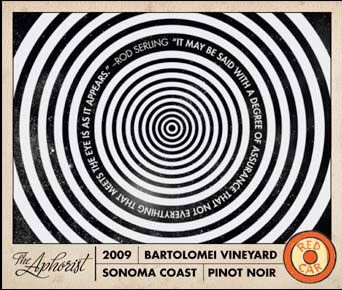
2009 Red Car Dreamland Platt Vineyard Sonoma Coast Pinot Noir 13% alc., pH 3.66, TA 0.573, 90 cases, $60. Released April 2011. An extreme site that struggles to set fruit. Calera, 777 and 828 clones. Densely planted and farmed intensively. 5% whole cluster. Native fermentation. Aged 15 months in 25% new French oak barrels. · Moderate purple color in the glass. The most intense aromatics in the lineup with charming aromas of black cherries, black raspberries, plums, exotic spices including cardamom and even dried rose petals and a hint of fecundity. Intensely fruited on the palate with a panoply of cherry and berry flavors that play off each other and dance on the palate. Notable tannins at this young age, but silky and light on its feet. My only nit is a very slight green note which I attribute to a slight under ripeness or oak. Very good.
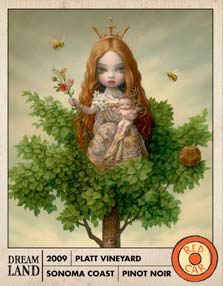
2009 Red Car Heaven & Earth Bohemian Station Vineyard Sonoma Coast Pinot Noir 14.2% alc., pH 3.74, TA 0.58, 340 cases, $65. Released April 2011. From the 4.5-acre La Boheme Vineyard located less than one mile from the town of Occidental. Planted in 2004 to Calera, Pommard and Dijon 828. A sheltered cool site. Native fermentation. Aged 15 months in 41% new French oak barrels. · Moderate purple color in the glass. Takes some coaxing to bring out aromas of black raspberries and forest floor. Flavors of earth-kissed black fruits build in intensity over time in the glass. The lightest in weight of the Red Car reserve Pinots, but the most charming fruit profile. A killer the next day from a previously opened and re-corked bottle. Still simple and relatively backward, so patience is advised. Open this beauty in three years and you will wish you had bought more of it. Wines like this fuel my passion for Pinot Noir.
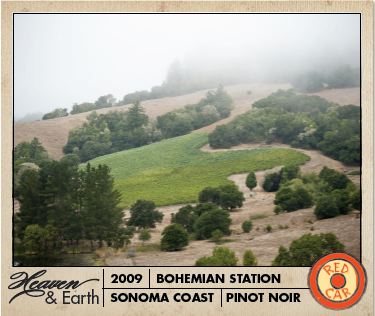
Rhys Vineyards Owner Kevin Harvey is a Burgundy fanatic and he has spared no expense to stake a claim to “Beaune in the USA” in the Santa Cruz Mountains. He now has five vineyards in the Santa Cruz Mountains region and a vineyard in Anderson Valley. 2007 was the first vintage in which all five Santa Cruz Mountains vineyards were in production (Home, Family Farm, Alpine Road, Horseshoe Ranch and Skyline). 2008 was the first vintage from Bearwallow Vineyard in the Anderson Valley. The focus is on Pinot Noir and Chardonnay produced from primarily heritage and suitcase clones and the wines are some of the most distinctive terroir-driven examples produced in California today. The talented winemaker is Jeff Brinkman. A new 30,000 square-foot underground winery at Skyline Vineyard in the Santa Cruz Mountains was finished in 2010. This is a world apart from the 4-car garage next to Home Vineyard where the first two commercial vintages of 2004 and 2005 were produced.The wines are in the cult category, highly allocated and sold only through a mailing list. Allocations are based on aggregate purchase history. Visit the website at www.rhysvineyards.com for more information and to join the list. Small amounts of Syrah and magnums of Rhys Pinot Noir are also released. I recently sampled three of the 2008 Rhys Vineyards Pinot Noirs, and although they were very good with gleaming potential, they are currently closed down with the fruit buried in the tannic structure. They reminded me of the 2005 Burgundies at this stage. I asked winemaker Jeff Brinkman about the dilemma that many wineries are faced with when they attempt to produce age worthy wines for connoisseurs, while still offering some modicum of approachability early to appease the eager consumer. He commented as follows. “The 2008 Pinot Noirs are going to sleep. We started to see it right around the end of the year, but it is something we have come to expect. It appears that after bottling, the wines stay pretty much open for around a year, give or take, and then start to shut down. During that time, the aromas are mostly there, but the palate is tight and angular. The 2007 wines are still asleep, but the 2006 wines seem to be coming around recently. With limited experience it is hard to say what will be a normal amount of time for them to be closed, but it looks like 2 to 3 years might be a good guess. We have been discussing how to make the wines more open but maintain the ability to cellar them. Starting in 2009, we stopped doing any kind of pigeage during cold soak to further limit extraction. The 2009 wines were bottled a few months ago and are open for right now, but we are really curious to see if and when they go to sleep and for how long. Our overall percentage of stems has gone down a bit over the last two years based on what we are learning to how different sub-blocks of our vineyards respond to whole cluster. We want our customers to be able to enjoy the wines and age the wines, but we also understand that people want to open the wines and enjoy them early, so it is a big challenge trying to satisfy both of those criteria. We always tell our customers that our wines are built for the long haul and advise them to cellar them all, including the Chardonnays, for a couple of years before opening. We also tell them to always decant the wines before drinking. I think the idea of California Pinot Noir shutting down like this is somewhat rare, so it is uncharted territory for us, but we are trying to understand it as best we can.” I find it very challenging to evaluate young or closed wines and predict how they will evolve in years to come. It would take someone a lifetime of tasting many vintages of one producer to be able to have predictions that would have predictable validity for that producer. I feel like I have became a fairly good judge of potential but I am the first to admit that it is far from an exact science. I look for balance primarily, because this is an excellent predictor of age ability, although some wines that are not in balance may become so over time. I often taste wines the day after opening a bottle and the following day, and even several days later after they are opened to get a feel for age worthiness. My evaluations are based primarily on the way wines are drinking the day they are opened, with some weight given to potential if it is reasonably assumed. It is clear some wines that are rated “Good” or “Very good” will at some future moment achieve my highest “Pinot Geek” accolade or vice versa. My reviews are dated, so readers can understand how the wine tasted on that date, and along with my recommendations when appropriate, make their own decisions regarding future improvement and drinkability. Fortunately, most consumers drink their wines when relatively young, so my ratings are of practical value.
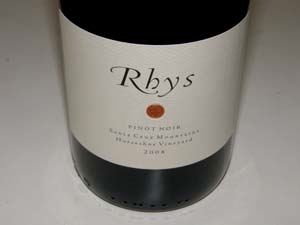 2008 Rhys Vineyards Horseshoe Vineyard Santa Cruz Mountains Pinot Noir 12.8% alc., $59. 10.85 acres, 1450’-1610’ elevation with 20%-25% slope. Suitcase clones (Swan, Calera and La Tache). 18”-24” rocky top soil over Monterey shale. Yield .7 tons per acre. · Dark reddish-purple color in the glass. Shy nose initially, opening over time to reveal enticing aromas of dark cherries and raspberries, Chinese Five Spice and faint oak. Luscious black raspberry fruit buried in prodigious tannins and bright acidity. About the same the following day from a previously opened and re-corked bottle. I get the feeling this wine will be significantly better in another 3 to 5 years. Very good.
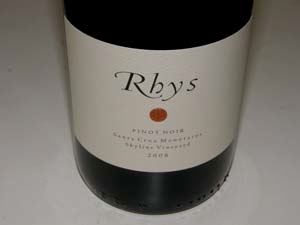 2008 Rhys Vineyards Skyline Vineyard Santa Cruz Mountains Pinot Noir 12.2% alc., $69. 2.12 acres at 2280’ to 2375’ with 20%-35% slope. Mixed suitcase clones closely planted. 2”-4” of top soil over Lorenzo shale and limestone. Yields 1.24 tons per acre. · Dark reddish-purple color in the glass. Plenty of aromatic interest with scents of blackberry preserves, black currants, and kirsch with hints of spice and green garden. Tasty core of dark plum and berry fruits with complimentary oak highlights. Richly fruited, crisp and juicy, with noticeably firm, prominent tannins, and a refreshing lift of acidity on the bright finish. The most restrained tannins of the wines tasted here and the most approachable of the three wines. About the same the following day from a previously opened and re-corked bottle. Very good.
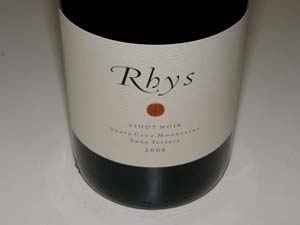 2008 Rhys Vineyards Swan Terrace Alpine Vineyard Santa Cruz Mountains Pinot Noir 13.0% alc., $69. 1.5 acres, 20% slope, planted to a Swan field blend in 6’x4’ spacing. 12”-18” topsoil over soft shale. Yields 1 ton per acre. · Moderately dark reddish-purple color in the glass. With intense swirling, an appealing scent of mixed berry preserves, crushed black grapes, and a hint of floral perfume emerges. The wine offers well-endowed flavors of plum sauce and dark red raspberries, cola and grilled meat. Rather linear now with the fruit buried in flamboyant tannins. There is some earth and mineral infused quality to the fruit which is appealing and I sense that this wine will perform beautifully in another five years. The wine benefited from re-corking the bottle and sampling it the next day. A connoisseur’s wine with unlimited potential.
Windy Oaks Estate Vineyards & Winery Jim and Judy Schultze left the high-tech corporate world and used their over twenty years of interest and experience in artisan winemaking and winegrowing to create Windy Oaks Estate in the southern Santa Cruz Mountains enclave of Corralitos. Jim developed his winemaking skills in Australia and Burgundy. The Burgundian varietals, Pinot Noir and Chardonnay, are produced from a 15-acre estate vineyard located at 1,000 foot elevation on a ridge overlooking Monterey Bay. Viticulture and winemaking at the on-property winery is very Burgundy-themed. The vineyard is farmed according to strict sustainable, organic principles with all the vines hand tended and directly monitored for water status. The site is extraordinary in that it is free of heat spikes, experiences significant diurnal variation in temperature, and has one of the longest growing seasons in California. Jim also farms two other nearby estate vineyards for a total of 26 acres of Pinot Noir. Nine small lots of Pinot Noir are currently released including (from lowest level to top level) Terra Narro, Estate Cuvée, Diane’s Block, Henry’s Block, Wood Tank, Whole Cluster, Wild Yeast, Proprietor’s Reserve and Special Burgundy Clone for an annual total of 2,000 cases. Some wines are only sold to Wine Group members. Jim is very innovative and always tinkering to improve the quality of his wines (note the 5-year air-dried French oak barrel with the gold stays in the photo below). The Schultzes have opened a new tasting room on the property and welcome visitors. The wines are quickly sold to an eager mailing list at www.windyoaksestate.com. Some wine is available on the website. Wine group members receive a significant discount.
2007 Windy Oaks Estate Limited Release Wood Tank Fermented Santa Cruz Mountains Pinot Noir 14.2% alc., 45 cases, $55. Fermented in one-ton, French oak, open fermentation tanks. Aged 21 months in 45% new French oak. · Moderately light reddish-purple hue in the glass. Shy fruit, with more forward aromas of oak and forest floor. Discreetly concentrated core of dark red cherry and berry flavors with cherry clinging to the fruit-laden finish. Silky textured with impeccable balance. Very good.
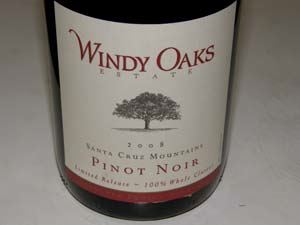 2009 Windy Oaks Estate Limited Release 100% Whole Cluster Santa Cruz Mountains Pinot Noir 13.9% alc., 173 cases, $55. 100% whole cluster protocol is unusual, even in Burgundy. Aged 21 months in 45% new French oak barrels. · Moderately light reddish-purple color in the glass. Remarkably effusive aromas of black cherries, vanilla, musk and spice. Delicious essence of fresh black cherry pie with subtle notes of baking spices, cola, and oak. Almost creamy, with moderate fine-grain tannins. Discreetly rich and fully ripe fruit with a striking note of cherry on the finish. The whole cluster fermentation confers a seductive mouth feel and a charming spice note. Very special.
2008 Windy Oaks Estate Limited Release Wild Yeast Santa Cruz Mountains Pinot Noir 13.9% alc., 133 cases, $55. Aged 17 months in 65% new French oak barrels. · Moderately light reddish-purple color in the glass. Unique aromatic profile featuring scents of cherries, wild marionberries, oak cask, raisin and fresh fig. The flavors echo the nose with cherry notes that are especially vivid. A riper fruit profile wine with appealing restraint and remarkable persistence on the finish. Very good.
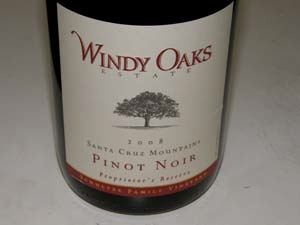 2008 Windy Oaks Estate Proprietor’s Reserve Santa Cruz Mountains Pinot Noir 13.9% alc., $60. · Brooding but alluring perfume of black plums, blackberries and black currants. Moderate purple-red color in the glass. Middle weighted but full flavored fruit that really strikes a chord. Offering an array of red and black fruits with faint oak and dark chocolate accents, this sleek and silky wine has a memorable finish with lingering aromatic interest. Best ever Proprietor’s Reserve from Windy Oaks.
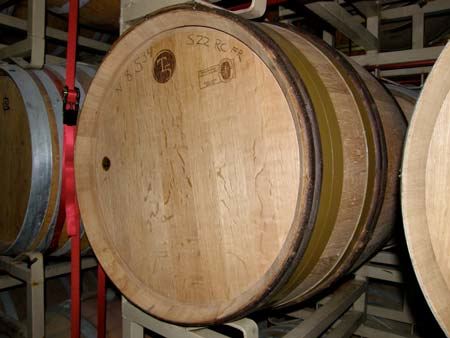
More Sips of California Pinot Noir2009 Anthill Farms Anderson Valley Pinot Noir 13.2% alc., $39. · Moderately light reddish-orange color in the glass. Faint aromas of red berries with a floral and minty oak overtone. Light in weight with flavors of red cherries and blood oranges, sporting mild slightly grainy tannins, bright acidity and some tartness on the finish. Disappointing at this price level. Decent.
 2009 Anthill Farms Tina Marie Vineyard Russian River Valley Pinot Noir 14.1% alc., $50. From a site in the Green Valley farmed by Ron Black and Stephen Bessone. · Moderately deep reddish-purple color in the glass. Opens with appealing raspberry on jam aromas, fading in the glass. The flavors are more promising, with a tasty core of Morello cherry and black raspberry, an herbal note and a good tug of citrus on the hi-wire finish. Good.
2008 Calicaro Split Rock Vineyard Sonoma Coast Pinot Noir 14.8% alc., pH 3.66, TA 0.63, 12 cases, $47. Picked at 27.9º Brix. Aged 11 months in 50% new French oak barrels. · Moderately dark reddish-purple color in the glass. Opens with appealing aroma of plum reduction sauce, fading into a muddled aroma of leaf and green garden with absent fruit. Moderately rich and creamy with a very ripe and sweet dark fruit profile with notes of raisin and green oak in the background. Has the bones to support the generous fruit flavors, but turns boozy on the finish. Decent (-).
 2007 Dierberg Estate Grown Santa Maria Valley Pinot Noir 14.1% alc., 2,700 cases, $42. Released January 2011. The Dierberg Vineyard is located at the southern end of the Santa Maria Valley AVA just 14 miles inland from the Pacific Ocean. · Dark purple in color in the glass. Shy fruit aromas with prominent smoky oak. A husky, full-bodied wine with generous earth-kissed black fruits underscored with flavors of tar, earth and anise holding on to the finish. Muscular with thick, rugged tannins. Should benefit from more time in the bottle, but will always be a bruiser. Good.
 2009 Hahn SLH Estate Santa Lucia Highlands Pinot Noir 14.5% alc., pH 3.59, TA 0.62, $35. Aged in 35% new French oak barrels. · Moderately dark purple-red color in the glass. Aromas of black cherry, boysenberry, kirsch, toasted bread and oak char. Moderately rich core of juicy dark red fruits with thick oak flavors. Decent.
I have been impressed by the La Crema appellation series wines in the past, especially at the under $25 price point. Recently there seems to be a trend to upgrade the image of these wines. Very heavy bottles are being used and the prices now are closer to $50 than $20. The two 2009 Pinot Noirs reviewed here were not up to past standards, despite the apparent upscale trend.
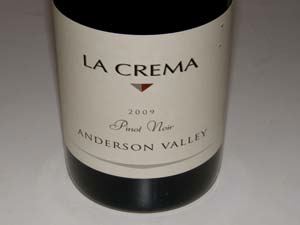 2009 La Crema Anderson Valley Pinot Noir 14.5% alc., pH 3.68, TA 0.52, 2,700 cases, $50. Sourced primarily from the Maggy Hawk Vineyard (close to Navarro) in the deep end of the Anderson Valley. Clones 667, 777, 115, 2A, 23, Pommard and 828. Aged 9 months in 36% new French oak barrels. · Moderate reddish-purple color in the glass. Intensely fruity nose initially displaying aromas of fruit bin and mixed berries including strawberries with a hint of vanilla fading over time in the glass. An array of tasty ripe berries is accented by a note of dark chocolate with a grip of citrus peel on the finish. Welcoming fruit intensity coats the palate and persists on the finish, but offers no nuance or intrigue. Smooth and harmonious. Over time, the wine becomes less interesting in the glass. The flavors trump the nose at this point. Worth revisiting in 6 months. Good.
2009 La Crema Russian River Valley Pinot Noir 14.5% alc., pH 3.72, TA 0.54, 5,800 cases, $40. Clones 667, 777, 115, Martini, 114, 23, 828 and Pommard. Aged 10 months in 51% new French oak barrels. · Moderately intense reddish-purple color in the glass. Shy nose with demure aromas of black cherries, forest floor, and oak. Moderately rich and weighty black cherry, raspberry, licorice and cola flavors with unbridled tannins. Slightly hot on the finish. Unchanged the following day from a previously opened and re-corked bottle. Plenty of fruit, but no finesse or nuance. Decent.
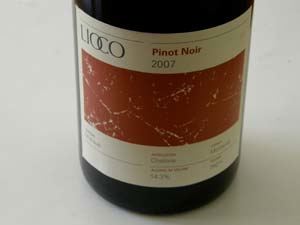 2007 LIOCO Michaud Vineyard Chalone Pinot Noir 14.3% alc., pH 3.77, TA 0.61, 343 cases, $48. The vineyard is located on a remote hilltop 1600 feet elevation with huge daily temperature swings. Granite and limestone soils. 10- day cold soak, native fermentation, aged 12 months in 1, 2 and 3-year-old French oak barrels. Unfined and unfiltered. · Moderate reddish-purple color with slight haze in the glass. Very ripe dark berry fruit aromas augmented by scents of shoe box, oak, and brier. Very flavorful cherry and red berry fruit under a thick blanket of tannin, persisting on the lengthy finish. A cola and spice note add interest. Still drank nicely two days after opening from a re-corked bottle. A wine with soul and vivid expression of site. Very good.
2009 LIOCO Hirsch Vineyard Sonoma Coast Pinot Noir 13.5% alc., pH 3.76, TA 0.61, $60. 40% whole cluster, wild yeast 18 day fermentation, aged 12 months in 1, 2 and 3-year-old French oak barrels. · Moderate purple-red color in the glass. This wine shows some acetaldehyde (rotten apple core) aromas and flavors after initially displaying aromas of dark strawberries, Asian Five Spice, and black raspberries. The flavors echoed the aromas initially but a spiced, oxidized apple flavor developed over time. A flawed bottle. Unsatisfactory.
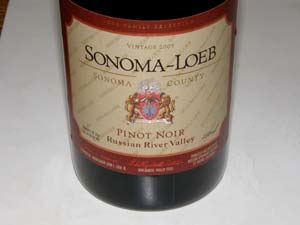 2009 Sonoma-Loeb Russian River Valley Loeb Family Selection Russian River Valley Pinot Noir 14.5% alc., $40. · Darkly colored in the glass. Shy and muted fruit aromas which emerge slowly with swirling. Full-bodied essence of black cherries and boysenberries with a hint of oak spice. Soft in the mouth with dry, youthful tannins. A little more expressive the following day from a previously opened and re-corked bottle. Big bottle, big fruit, big tannin but doesn’t deliver much interesting flavor or nuance. Decent.
 2009 VML Virginia Marie Lambrix Boudreaux Vineyard Russian River Valley Pinot Noir 15.3% alc., 235 cases, $45. · Moderate reddish-purple color in the glass. Initially the nose is quite fruity displaying aromas of black cherries, dark plums, and black raspberries. Over time in the glass, the fruit recedes to the background and oak takes over. Full-bodied flavors of blueberries and black cherries which are on the ripe side. Underpinnings of oak spice and oak char are a bit intrusive. The fruity finish is noticeably dry and tannic leaving some heat in its wake. Decent.
Sips of Oregon Pinot Noir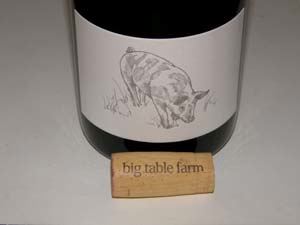 2009 Big Table Farm Willamette Valley Pinot Noir 13.3% alc., 92 cases, $38. The fruit is primarily from the Johan Vineyard. 75% whole cluster, native yeast fermentation, aged 10 months in one new and two used French oak barrels. · Moderately light reddish-purple color with a slight haze (unfiltered) in the glass. Aromas of berry patch, farmyard, smoke, tar and pine. Medium weighted flavors of blueberries, cherries and boysenberries with hints of cola and a fairly strong tarry note from the whole cluster. Supple, fine-grain tannins with a soft mouth feel. Tasted twice a few months apart. Decent.
2008 Winderlea Vineyard & Winery Dundee Hills Vineyards Oregon Pinot Noir 14.5% alc., $36. · Moderate reddish-purple color in the glass. Alluring aromatics displaying scents of black cherries, violets and a hint of oak spice picking up intensity over time in the glass. A fruity wine with a tasty core of cherry and berry fruit accented by oak-driven flavors of anise, vanillin and smoke. A good snap of acidity brings up the refreshing finish. The most approachable of the three 2008 Winderlea wines. Still fine two days later from a previously opened and re-corked bottle indicating it will last in the cellar. Good (+).
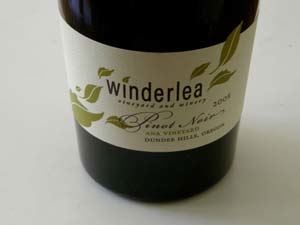 2008 Winderlea Vineyard & Winery Ana Vineyard Dundee Hills Oregon Pinot Noir 13.5% alc., $50. Own-rooted vines planted in 1976 on a 350’ to 450‘ ridge. Pommard and 777 clones. Owned and farmed by Andy Humphrey. · Moderately light reddish-purple color in the glass. Nicely perfumed mix of berries with a strong scent of oak. Tasty core of red strawberries and raspberries and chocolate-covered cherries with an underpinning of oak char that fans out on the palate. Still a bit rough hewed and tannic, but offers some charming fruit that has good persistence. Should improve in the cellar as the tannins meld and the oak integrates further. Very good.
2008 Winderlea Vineyard & Winery Winderlea Vineyard Dundee Hills Oregon Pinot Noir 13.3% alc., $53. From a 20-acre estate vineyard planted in 1974 (formerly Goldschmidt Vineyard). 480 foot elevation, southwest exposure, Jory soils. · Moderately light reddish-purple in the glass. Shy dark red fruit aromas with hints of baking spice, dried herbs and oak. Delicate flavors of red cherries, cranberries and red currants finishing with a hint of oak, green herbs, spice and grapefruit peel. A bit shallow on the mid palate and finish, leaving you wanting more. Soft and silky in the mouth with a lively grip of acidity. Picks up some charm over time in the glass. Still holding its own two days later from a previously opened and re-corked bottle. Tasted twice with consistent results. Good (+).

Pinot That’s Easy On the Wallet
but you will never get what you don’t pay for. It is a sad fact that inexpensive, high-quality Pinot Noir is almost non existent.” Allen Meadows, Burghound You can’t argue with Meadows’ statement above, but sometimes you are not compelled to drink an epiphany. There are times when you are looking for a Pinot Noir that you can buy by the case, drink it without impunity in a casual setting, and not feel obligated to critique the wine. Here is an analogy: if you are a foodie, you love to have a gourmet meal on occasion, but there are times when an In-N-Out burger will do just fine. Because there is plenty of excess Pinot juice available, and because the recent recession has pinched many wineries, negociant labels have been able to pick up some pretty solid wine and produce inexpensive Pinot Noir that taste very decent. Many premium wineries have launched second value-priced labels as well which have become popular. In addition, some wineries have chosen to concentrate on the under-$20 market. Inexpensive wines do not have layers of aromatic and flavor interest and long, generous finishes, but they can work beautifully as daily drinkers and back porch wines. According to Wines & Vines (May 2011), Pinot Noir, along with Pinot Gris, was the biggest selling varietal priced between $11 and $14.99. In this issue, also look at the 2009 Carmel Road Monterey Pinot Noir ($20).
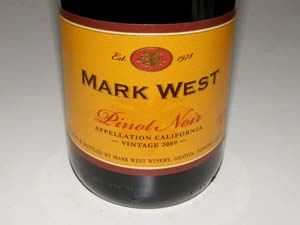 2009 Mark West California Pinot Noir 13.8% alc., $8.50. Small tank fermentation, punch downs, pressed lightly and aged for 8 months in French and Hungarian oak. · Moderately light reddish-purple color in the glass. Shy aromas of red cherries, strawberries and oak vanillin. Lightly fruited, but tasty melange of red cherries and berries with oak in the background. Mild fine-grain tannins with balanced acidity. Well worth the tab. Good.
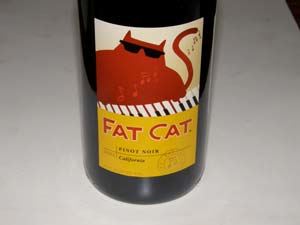 2009 Fat Cat California Pinot Noir 12.5% alc., pH 3.56, TA 0.56, Glucose/ Fructose 4.25 g/L, $10. From Bronco Wine Company. Winemaker John Allbaugh. · Faint perfume of dark fruits. Fairly rich and tasty core of plum and blackberry flavors with some oak in the background. Mildly firm tannins provide structure and restrained oak contributes interest. Not easily recognizable as Pinot Noir, but a casual and mellow drink that matches the jazz theme on the label. Decent.
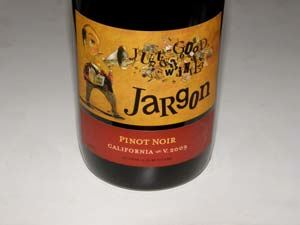 2009 Jargon California Pinot Noir 13.5% alc., $10, screw cap. · Moderately light purple-red hue in the glass. Fresh scent of berry jam, spice and vanilla. Medium weighted flavors of red berries and spiced cherries wrapped in supple tannins. Nicely balanced with a silky texture that makes for easy drinking. Definitely tastes like Pinot and will please many at this price. Good
13.9% alc., $18. · Moderate reddish-purple color in the glass. Lacks fruit on the nose, offering only aromas of oak, pine sap and savory herbs. Moderately rich core of dark red stone fruits wrapped in soft tannins. Prominent oak presence evidenced by vanillin and assertive herbs carries over on the finish. Decent.
 2009 Pali Wine Co. "Huntington" Santa Barbara County Pinot Noir 14.5% alc., 1,215 cases, $19, screw cap. Part of Pali Wine Co.’s Cuvée Program of appellation-specific Pinot Noir using purchased grapes declassified from the premium wine lineup. Aged 15 months in 30% new French oak barrels. · Moderately intense color in the glass. The aromatics are striking with a plethora of black cherry, black raspberry and spice box aromas veering to the riper side. Modestly intense flavors of black cherries, dark berries and black currants with a smoky edge. The fruit closes in on over ripeness. Juicy with restrained tannins and a lingering note of cherry on the fruity finish which could use an acid uplift. Decent (+).
 2009 Sarapo Family Wines Donato Carneros Pinot Noir 14.1% alc., $19.95. Second label from Eric KentWine Cellars. · Moderate reddish-purple color in the glass. Nicely perfumed with aromas of black cherries, spice box, oak and baked cookies. Medium weight core of tasty dark cherry and blackberry fruit with a hint of mocha in the background. The velvety texture is appealing, but the alcoholic finish detracts. Good acidity and mild tannins. A reasonably good daily drinker in an attractive package. Good (-).
 2008 Red Pony Ranch Central Coast Pinot Noir 14.4% alc., $14. · Medium purple-red color in the glass. Demure aromas of dark red fruits including strawberries with hints of redwood and spice. Veers to an over ripe flavored array of dark red Pinot fruits including strawberries, cherry skins and raspberries. Restrained tannins make for easy drinking. A subtle greenness scars the finish which is short. Decent.
2008 River Road Vineyards & Winery Scarlett Russian River Valley Pinot Noir 14.1% alc., $17. A barrel selection. · Moderate reddish-purple color in the glass. Aromas of dark red berries, black cherries, vanilla and sandalwood. Reasonably complex with an array of flavors including black raspberries, black cherries, tea leaves, and grilled meat. A little too much oak detracts. Very dry tannins and finish. Might benefit from more aging or decanting. Decent (+).
2008 Quails’ Gate Okanagen Valley Canada Pinot Noir 14.0% alc., $18, screw cap. · Moderately light reddish-purple color in the glass. Aromas of tobacco smoke and burnt wood. The fruit has a burnt quality and is unpleasant. A flawed wine. Unsatisfactory.
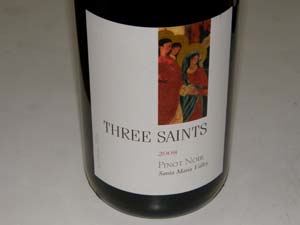 2008 Three Saints Santa Maria Valley Pinot Noir 14.1% alc., 2,500 cases, $24, screw cap. Released February 2011. · Dark ruby color in the glass. Scent of black cherries, toasty oak and pencil lead. Middle weight flavors of blackberries, black grapes and dark plums with underpinnings of toasted oak and tobacco. Nicely composed and easy to drink. Decent.
Recent Chardonnays to RecommendGood California Chardonnay is ubiquitous, and great California Chardonnay is out there if you know where to look for it. Chardonnay is California’s most widely planted grape (90,000 acres) and is the most popular wine varietal among American consumers. Chardonnay thrives in eight California appellations known for Pinot Noir (Sta. Rita Hills, Santa Maria Valley, Santa Lucia Highlands, Santa Cruz Mountains, Carneros, Russian River Valley, Sonoma Coast, and Anderson Valley), with stunning examples showing up from lesser-known regions as well such as the Mendocino Ridge AVA. My personal taste veers toward barrel-fermented Chardonnay, but with appropriate foods, I can easily be satisfied with a stainless steel-fermented style. Chardonnays from cooler regions of California tend to have more restraint and mineral-infused acidity. Those from warmer regions such as the Russian River Valley veer toward richer, more tropical-fruited offerings. The following wines have all been sampled within the last two months.
2007 Alysian Cresta Ridge Vineyard Taurin Block Russian River Valley Chardonnay 14.1% alc.,pH 3.47, 378 cases, $38. 100% barrel fermented, 50% MLF. Aged 10 months in 40% new and 60% one and two-yearold French oak barrels. · Aromas of grilled pineapple, baked pear, lime, sawdust and hay bale. The flavors echo the nose with added notes of baked apples and lemon zest with a faint woody note. Nice harmony and well-crafted, but the aromatic profile is strange. Not nearly as good as a bottle I had last year that I rated highly. Decent.
2008 Alysian Starr Ridge Vineyard Clone 95 Russian River Valley Chardonnay 14.3% alc., $38. · Very shy aromas of apple, pear and honey. Restrained and lean with demure flavors of Asian pears, white peaches and vanilla caramel. Smooth and silky and easy to cozy up to. Good (+).
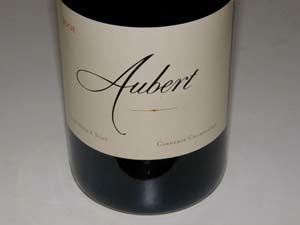 2008 Aubert Larry Hyde & Sons Carneros Chardonnay 15.8% alc., $80. · Golden yellow with a slight green caste and very slight haze in the glass. Prominent aromas of baked apples and pears and buttery oak. A feast of baked pears, apple pie, roasted nuts and butter brickle, richly presented with an impressive fruit intensity on the big finish. Better the next day from a previously opened and re-corked bottle. Alcohol peaks out on the finish as the wine warms in the glass. This is a hedonistic style of Chardonnay best enjoyed by itself. Regrettably, although the higher alcohol adds body and texture, it limits the amount you can drink. Best to sip. Very good.
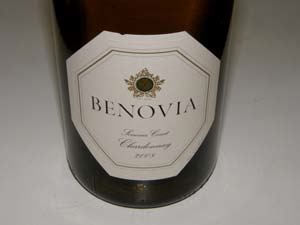 2008 Benovia Sonoma Coast Chardonnay 14.2% alc., $32. · Light straw color in the glass. Bright aromas of baked apples, butterscotch and banana peel. Moderately light in style with mildly creamy flavors of green apples, white peaches, vanilla, caramel and brioche. Clean, sharp, focused. Good.
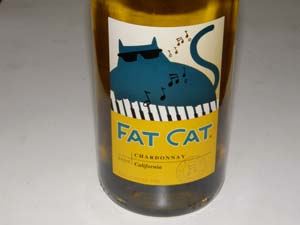 2009 Fat Cat California Chardonnay 12.5% alc., pH 3.34, TA 0.62, Glucose/ Fructose 8.47 g/L, $10. · Very shy nose with faint aromas of green apples, pears, and oak vanillin. An easy drinker with pleasant and confected flavors of pears, toffee, green apple candy, and spice. A respectable “chick” quaff, especially when chilled, that has low alcohol and will please the crowd of wine drinkers who like residual sugar in their Chardonnay. Not for connoisseurs. Decent.
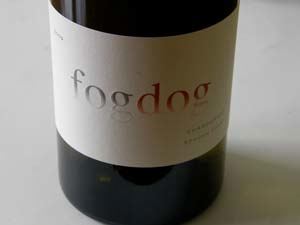 2009 Fogdog Sonoma Coast Chardonnay 13.5% alc., $35. 42% Pastorale Vineyard and 58% independent growers. Aged 12-14 months in 35% new and 65% 2 to 3-year-old French oak barrels. · Light straw color and clear in the glass. Classic Chardonnay aromas of pears, lemon curd, guava and buttered brioche. Tasty and moderately rich core of pear, citrus, green apple, caramel and butter flavors with a refreshing lift of acidity on the bright finish. A thoroughly pleasing drink that sings with quality. Very good.
2009 Hahn Estate SLH Santa Lucia Highlands Chardonnay 14.5% alc., pH 3.53, TA 0.59, $25. Aged in 42% new French oak barrels. · Light straw color and clear in the glass. Fragrant with aromas of golden apples, apple crisp, pears and butter with a heavy nod to oak over time in the glass. Tasty array of flavors including baked apples, pastry cream, toffee and vanilla. A solid drinker. Good.
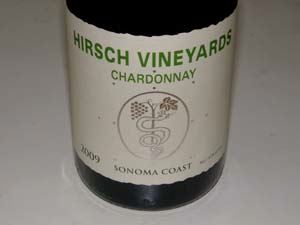 2009 Hirsch Vineyards Sonoma Coast Chardonnay 14.0% alc., $44. Fermented and aged in glass, stainless steel and oak. All estate fruit. · Very fragrant with scents of apple pie, brioche, yeast and wet rocks. Crisp and juicy with flavors of white peaches, apples and yeast with apple hi-notes persisting on the acid-driven and minerally finish. Very good.
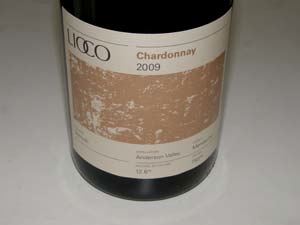 2009 LIOCO Demuth Vineyard Anderson Valley Pinot Noir 12.6% alc., pH 3.46, TA 0.66, $35. A mountain top vineyard at 1600 feet elevation. Wente clone on original rootstock planted in 1982. 40 degree diurnal temperature swings, late harvest dates, low yields. Whole cluster pressed and cold fermented in stainless steel only. Wild yeast fermentation and natural MLF. Aged 6 months with fine lees contact. Unfined and unfiltered. · Faint straw color in the glass. Aromas of canned peaches, green apple and hay bale. Crisp and minerally flavors of green apples, lime and lemon, and pear, with a nutty note in the background. Bright acidity, slightly tart, with an hi-strung finish. Would have liked some oak on this fruit. Good (+). Note: I really like the back labels of LIOCO wines which provide all the information you want with no fluff.
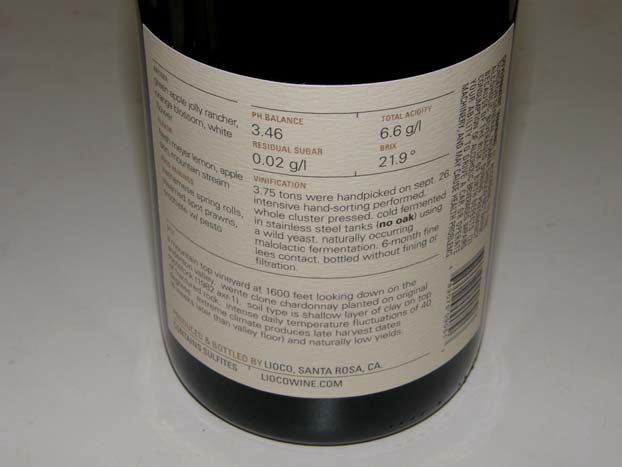
2008 Lucia Santa Lucia Highlands Chardonnay 14.1% alc., $35. From three small blocks at Pisoni Vineyards. Few connoisseurs are aware of the tiny parcels of Chardonnay on the property. Originally planted in 19082, these old Chardonnay vines prosper in the cool climate. · Medium straw color in the glass. Aromas of ripe pears, pineapple and honeyed biscuit. Delicious baked pear, apple pie and toasted brioche flavors with a citrus high note in the background. Smooth and silky with some persistence on the finish. A warmer climate style not particularly high in acid or minerality but thoroughly delightful.
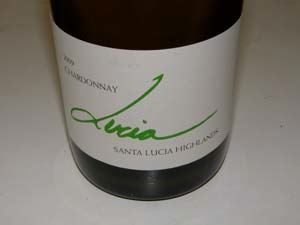 2009 Lucia Santa Lucia Highlands Chardonnay 14.1% alc., 435 cases, $40. Produced from three small blacks at Pisoni Vineyard planted in 1982 using a prestigious Montrachet selection from a famous producer in Burgundy. Unfiltered. · Light golden straw color and clear in the glass. Nicely perfumed with aromas of pears, papaya, banana and brioche. Delicious flavors of pears, creme brulee, white peaches and light caramels. Soft and slight creamy with no hard edges and commendable balance. Fruit is emphasized over acidity. Will have many fans. Very good.
 2007 Mount Eden Vineyards Santa Cruz Mountains Chardonnay 13.8% alc., 1,375 cases, $42. · Moderate straw color in the glass. Aromas of fresh-picked apples and toasty oak. Flavorful, mildly creamy and smooth with impeccable balance and breeding. Delicious flavors of baked apples, pears, citrus, honey and vanilla caramel. Restrained and nuanced, becoming more layered and interesting with time in the glass. A California classic that will age for years.
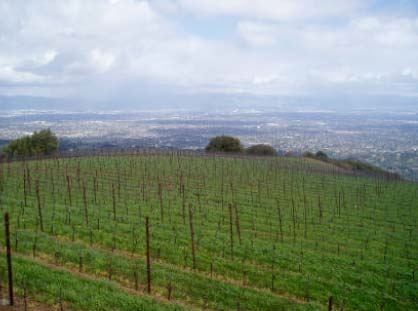
2009 Presqu’ile Santa Maria Valley Chardonnay 14.3% alc.,TA 0.725, $35. 60% Solomon Hills Vineyard and 40% Bien Nacido Vineyard. Clones 4, 96 and 95. Aged 14 months in 8% new French oak barrels. · Light straw color and clear in the glass. Aromas of tropical fruits and banana. Restrained, but pleasing flavors of apples, ripe pears, and jackfruit. Balanced and easy to drink. A mainstream Chardonnay that works as a daily drinker and will compliment many foods because of its vibrant acidity. Decent (+).
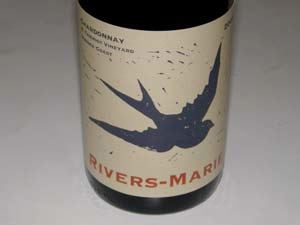 2009 Rivers-Marie B. Thieriot Vineyard Sonoma Coast Chardonnay 13.9% alc., 116 cases. Aged in 60% new French oak barrels. 100% MLF. · Honey color (second to some botrytis) and clear in the glass. Faint aromas of apple crisp and toasty oak. Delicious and complex with vivid flavors of baked pears, baked apples, honey, yeast, creme soda, toasted coconut and some citrus peel bringing up the finish. Many of the flavors upon opening are oak-driven but tasted the following day from a previously opened and re-corked bottle, there was more aromatic interest and less oak influence. Nicely balanced and very smooth on the palate with a good grip of acidity. A unique Chardonnay that will please the adventurous. Cellar or decant if you drink now. Very good.
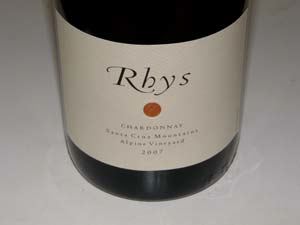 2007 Rhys Vineyards Alpine Vineyard Santa Cruz Mountains Pinot Noir 13.7% alc., $59. Clones are Hyde, Wente, 76 and 96 planted at 1380 feet elevation. Soils are 24” top soil over soft shale. Yield 1.28 tons per acre. · Light straw color in the glass. Crisp aromas of crushed rocks, metal shavings, flint, Asian pear and green apple. A restrained, classic style with flavors of green apple, lemon, and flint, enlivened by a good grip of acidity, finishing bone dry. A sophisticated and terroir-driven Chardonnay distinct from the commonplace California fruit and oak-driven style. Tasted two days later from a previously opened and re-corked bottle, the wine was fresh, crisp and taut. Burgundy nuts will go ga-ga over this wine.
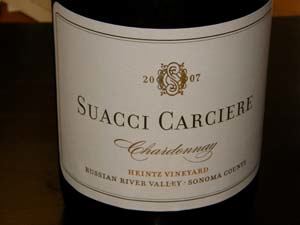 2007 Suacci-Carciere Heintz Vineyard Sonoma Coast Chardonnay 14.1% alc., pH 3.60, TA 0.70, 200 cases, $35. The winemaker is Ryan Zepaltas (Zepaltas Wines). Owners Andy Carciere and John D. Suacci. 50% fermented in stainless steel and 50% fermented in French oak. 100% MLF with aggressive lees stirring. Aged 11 months in barrel. · Light straw color and clear in the glass. Appealing scents and flavors of tropical fruits including pineapple and an array of lemons. Slightly rich and creamy, with just the right dose of oak to add a subtle brioche, vanilla and butter undertone to the sprightly and minerally citrus notes. Heintz Vineyard, regardless of who is making the wine, consistently produces some of California’s greatest Chardonnays. The name of this vineyard on a bottle is a badge of quality.
2008 Wind Gap “Yuen” James Berry & Brosseau Vineyards Central Coast Chardonnay 12.9% alc., pH 3.36, 525 cases, $35. Released April 2011. A new venture from Pam and Pax Mahle. Wente clone (33+ years at Brosseau Vineyard and 45+ years at James Berry Vineyard). 60% fermented with natural yeasts in concrete egg-shaped tanks with remaining 40% whole cluster pressed and fermented in stainless steel. MLF in multiple use French oak barrels. · Very light straw color in the glass. A delicate, lean wine offering scents and flavors of citrus fruits, pear and papaya. A Rhone-style white wine with bright acidity and no oak influence that is simple. Will work as an aperitif. Decent.
Burn Cottage FollowupIn a recent issue of the PinotFile (princeofpinot.com/article/1063/), I wrote about the debut of Burn Cottage Vineyard Pinot Noir from Central Otago, New Zealand. This 68-acre estate near Cromwell has just over 27 acres under vine and has been farmed biodynamically from the beginning. Ted Lemon (Littorai) is the consulting vineyardist and winemaker who has directed the biodynamic program from the beginning. The owners, Marquis and Dianne Sauvage, have recently released their Pinot Noir from the 2009 vintage and recently sent my a sample to review. I was extremely impressed and have included my comments below. The wine is imported to the US and on retail shelves now. The philosphy of winemaking is summarized on the website: “We believe in minimal intervention winemaking. We believe in minimizing sulfur usage and avoiding all additives whenever possible. We avoid the use of cultured yeasts, bacteria, associated nutrient products and filters. We avoid racking whenever possible and do wine work according to lunar and celestial rhythms.”
 2009 Burn Cottage Central Otago Pinot Noir 14.0% alc., pH 3.61, TA 0.56, 1,136 cases, $50. 11% whole cluster. Aged in 38% new French oak and 21% stainless steel barrels. · Moderate reddish-purple hue in the glass. Opens slowly in the glass, and was much more expressive both aromatically and flavor wise the following day from a previously opened and re-corked bottle. Fragrant with aromas of red plums, black cherries and spice box. Lovely flavors of Bing cherries and dark red raspberries with complimentary oak in the background that is a bit intrusive at this young age. Plenty of charm and elegance with a soft, smooth mouth feel and a spring to its finish. Needs more time in the cellar. Very good.
Total Wine & More Plans Total DominanceTotal Wine & More is advertised as America’s Wine Superstore, offering 8,000 wines, 3,000 spirits, and 2,500 beers at its large warehouse sized stores. 71 stores are operational in ten southwestern and southeastern states including high penetration in California. Today’s Los Angeles Times features a full page cover ad announcing the opening of two additional Southern California “superstores.” The firm was started in 1991 by David and Robert Trone who initially opened two wine stores in Delaware. Total Wine & More is now the largest independent wine retailer in the United States. They carry a vast selection of both domestic and imported wines, with about half of sales from each category.
 A 20,000 square-foot store opened a couple of years ago near me in Tustin, California. At first I was adverse to the concept, overwhelmed by the sheer size of the store and assumed the wines would be primarily supermarket variety. I was surprised to find they carried an extensive variety of top quality Pinot Noir from California and Oregon including labels such as Alma Rosa, Anam Cara, Argyle, Adelsheim, Archery Summit, Au Bon Climat, Brewer-Clifton, Calera, Cristom, Domaine Serene, Donum Estate, Etude, Hanzell, Hitching Post, Loring Wine Co., LIOCO, Miura, Saintsbury, Sanford, Siduri and Testarossa. They do not always carry the latest releases and do not have the complete offerings from a winery for a given vintage, but the selection is impressive. They also carry a wide variety of inexpensive Pinot Noirs in the $5 to $13 range including labels like Angeline, Bearboat, Castle Rock, Courtney Benham, Echelon, Irony and Muirwood. A number of inexpensive foreign imports from Italy, Corsica, the Languedoc, New Zealand and Australia of dubious quality are also offered. The point is, you have to know what’s good. The Chardonnay selection is equally impressive and I have found examples from many noted premium California producers (Dehlinger, Hanzell, Ramey). This is not a discount operation as prices are comparable to local wine speciality retailers. Total Wine & More does, however, offers incentives by publishing coupons in newspapers. The current offering is for $10 off every $50 spent, a savings of 20% (some items are excluded). I compared prices on fifteen premium Pinot Noirs with the prices at a local, well-known and highly regarded wine store. The wines included 2008 Belle Glos Clark & Telephone, 2008 Bergstrom Cumberland Reserve, 2008 Domaine Drouhin Oregon, 2008 Foxen Bien Nacido Block 8, 2009 Ken Wright (various), 2008 Loring Wine Co. Graham Family Vineyard, 2008 Siduri Santa Lucia Highlands, 2008 Penner Ash Willamette Valley, and 2008 Ponzi Reserve. The prices at Total Wine & More were the same for 80% of the wines, and a couple of dollars more expensive or less expensive for the other 20%. So, although Total Wine & More advertises “Lowest Prices,” for most wines this is not true unless a coupon is used as a discount. When I have been in the local Total Wine & More, I noticed that most people are using grocery shopping carts and loading them up with wines, often buying a few cases at a time. I never see this at a fine wine store where hand baskets are the usual mode of shopping. People buy in quantity here. A 119-page buying guide listing all the wines for sale with some brief information on some of the wines and scores from the usual sources are included. An impressive Total Guide to Wine is also published and given away at the stores. The store advertises “great customer service,” but since I do not ask for buying advice, I cannot verify this claim. There are a number of shelf talkers that are rather generic in nature and bland in style that promote certain wines, and some talkers that are written by employees with their photos displayed. What is the point of this? I see this as a serious threat to specialty wine retailers who usually provide more personal assistance, offer wines that in most cases have been tasted and evaluated by the staff, host extensive educational tastings, and spend considerable time in composing informative newsletters and mailings regarding their stock of wines. In the long term, with Total Wine & More stores appearing in many neighborhoods and with their advertising power, they are threatening to dominate the retail wine market. Many small retailers will simply not be able to compete. In the past, specialty wine retailers were able to offer wines that were not available to general retailers, and in some cases they still do, but Total Wine & More, as I detailed above, now offers many of these limited production labels. The large retailers, with their buying and advertising clout, whether for groceries, clothes, and electronics or other commodities, threaten the existence of the independent business person and sadly will continue to do so.
DRC vs The World Blind TastingCurtis John Marsh, who writes The Wandering Palate (www.thewanderingpalate.com) and recently reported on Allen Meadows and Ted Lemon visiting Singapore (www.burghoundinasia.com) send me a press release on the DRC vs The World Blind Tasting Results. This was one of the highlights of the Burghound in Asia event.
 On Friday, April 8, 2011, wine connoisseurs gathered at the St. Regis Hotel in Singapore for a two-hour tasting of Domaine de la Romanee Conti served with wines from four other wineries from America, Australia, Austria and New Zealand. There was much conjecture, and to a degree, misinterpretation of the objectives of this controversial tasting. This was the first ever structured comparative consumer-driven tasting of this genre to be held in Asia, and perhaps the world. There were 12 tables seating 9 participants made up of 8 consumers and 1 wine professional. The professionals include Andrew Jefford (UK), James Halliday (AUS), Allen Meadows (USA), and Singapore based Lisa Perrotti-Brown MW, Suzanne Brocklehurst and Ying Hsien Tan. Allen Meadows did not participate in ranking the wines and none of the professionals were involved in any way with organizing the tasting. Guest winemakers included Sam Neil (Two Paddocks, Central Otago), Josh Jensen (Calera Wine Co., USA), Veronique Boss-Drouhin (Maison Joseph Drouhin, Burgundy, France, and Domaine Drouhin Oregon, USA), and Francois Labet (Chateau de La Tour, Burgundy, France). A total of 88 legitimate preference score sheets were collected. There were 3 brackets of 5 world-class Pinot Noirs (15 in total) served half-blind (tasters knew the variety was Pinot Noir and that one DRC wine was in each bracket). The 100-point scoring system was used with their scores converted to a ranking from 1 to 5. The results were monitored and audited by a senior accountant from Ernst and Young. The wineries chosen for the tasting were: Felton Road (Central Otago), Bass Phillip (Victoria, AUS), Domaine Serene (Oregon), Markowitsch (Austria), and Domaine de la Romanee Conti (Burgundy). All the wines were sourced direct from the wineries, or in the case of DRC, direct from their official suppliers. The preferred wines by bracket ranked 1 to 5 with 1 being the most preferred: Bracket 1
1) Felton Road Block 3 2009
Bracket 2
1) Markowitsch Reserve 2006
Bracket 3
1) Bass Phillip Reserve 2003
Overall most preferred wine (with the nod to older vintages which have an advantage)
1) Bass Phillip Reserve 2003
Most prefered winery in all three brackets
1) Markowitsch
The Chairman of the tasting, Curtis Marsh, analyzed the results. “Markowitsch Reserve Pinot Noir from Austria clearly impressed the most. This is not the first time that Austrian red wines and specifically Pinot Noir have astounded palates in blind tastings. The results should engender much interest in Markowitsch and stir the curiosity of Pinot Noir lovers around the world to explore Austrian wines more. As for the most preferred wine, the Bass Phillip Reserve 2003, I believe it is a most worthy result and brings attention to the under appreciation and misinformation that Australia does not produce great Pinot Noir. There are many other commendable Pinot Noir producers to discover, and I hope this tasting inspires consumers to explore Australia’s cool-climate wines in a different light.”
Pinot BriefsDecanter magazine and S.F. Chronicle to list Alcohol Levels Finally, some widely read wine publications have recognized the importance of listing alcohol percentages of wines in wine reviews. I began doing this in 2005 in the PinotFile, and I believe I was the first to do so in any wine rating publication. Decanter reported that it made the decision in response to requests from readers, and admitted, “It’s not just a question of the alcohol’s impact on the taste of the wine. There are also health issues at stake, drunk-driving limits to consider, and the simple issue of intoxication.” Multiple Wineries Change Ownership Boisset Family Estates has added Buena Vista Carneros to its growing collection of wineries. Boisset already owns DeLoach Vineyards (Russian River Valley), Lyeth Estate (Alexander Valley), and Raymond Vineyards (Napa Valley). • The Vincraft Group, a Sonoma-based wine company, bought Gary Farrell Winery from Ascentia Wine Estates. In 2009, Vincraft made its first investment with the acquisition of Kosta Browne Winery. • Bill Foley continued to add to his winery portfolio with the purchase of Te Kairanga Wines, a 70,000 case winery in Martinborough, New Zealand. Foley Family Wines was established in 1996 with the acquisition of Lincourt Vineyards in the Santa Ynez Valley. Foley Family Wines produces nearly a million cases of wine annually. • Sonoma-Loeb was sold to Chappellet Vineyards.
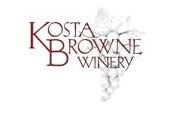 Kosta Browne to Build Winery in Downtown Sebastopol A new modern winery is to be built in The Barlow, located in the center of downtown Sebastopol. The opening of the new facility will mark Kosta Browne as the first bonded winery within the city limits. Grand opening is slated for fall 2012. The former Barlow Apple Factory is being reinvented to feature both production and retail for artisan wine, food and art producers. In addition, Sebastopol Farmers Market will be relocated to the site. Kosta Browne will more than double its space, from 18,000 square feet now to 45,000 square feet. The plan was to build big so they would never have to move again. The new winery will be in a much more public spot, but there is no plan to open a tasting room and Kosta Browne will continue to be open for visits by members of the mailing list by appointment. Changes at San Francisco’s Press Club The management of the urban tasting room, Press Club, has moved in a new direction and the founding wineries (Chateau Montelena, Hanna, Landmark, Fritz and Lost Canyon, Miner Family, Mount Eden, Pahlmeyer, and Saintsbury) will no longer have tasting bars at the Press Club. The venue will host visiting vintners who will rotate monthly to feature their wines.
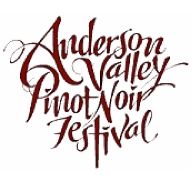 Anderson Valley Pinot Noir Festival The 14th Annual Festival will be held May 20-22, 2011, in Anderson Valley, California. Friday morning’s Technical Session will be followed in the afternoon with a Consumer Session that includes a Panel Discussion of Ferrington Vineyard, a tasting hosted by Karen MacNeil and a “Drink Pink” focus tasting. The Grand Tasting will be at Goldeneye Winery on Saturday from 11:00 to 3:00. Local Anderson Valley Open Houses will be held all day Sunday. Visit www.avwines.com for information and tickets. Marin County Wine Celebration The 7th Annual Marin County Wine Celebration will be held Saturday, June 11, 2011, at the historic Escalle Winery in Larkspur. The event benefits the Marin Agricultural Land Trust. Tickets are $55 and include valet parking and a wine glass. Featured wineries include Couloir Wines, DeLoach Vineyards, Dutton-Goldfield Winery, Pey-Marin Vineyards, Vision Cellars, Willowbrook Cellars, Kendric Vineyards and Sean Thackrey. A selection of locally produced foods including cheeses will be offered. Visit www.malt.org to obtain tickets.
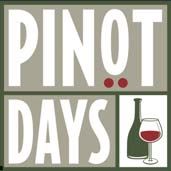 Pinot Days San Francisco The 7th Annual Pinot Days San Francisco will be held June 18, 2011. The Grand Festival at Fort Mason will feature over 200 producers of Pinot Noir from California and Oregon. This year’s Producer Spotlight tasting will feature Williams Selyem. Other seminars and tasting are planned as well. Visit www.pinotdays.com for information including a list of participating wineries, and to obtain tickets.
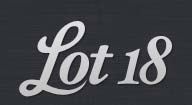 Flash Wine Sale Sites the Rage Flash wine sites on the web offering discounted wines have become big business over the past two years. The sites offer consumers small amounts of wine at discount. The offers typically last only a day encouraging buyers to rush to the opportunity for a significant discount (25%-50%). According to www.businessinsider.com, one of the most successful flash wine sale sites, Lot 18, which sells premium wines, is generating 7-figure sales every month. Launched only a little over six months ago, Lot 18 now has more than 220,000 registered users, 44 employees and 35 open positions. According to the New York Times, flash sales allow wineries to unload large amounts of wine in a very short time. The sites either sell the wine and let the winery do the order fulfillment and shipping, or the site buys the wines and fulfills the orders themselves. Other sites include: Wine.Woot, WineShopper, The Wine Spies, Cinderella Wine, Wines Til Sold Out. For more information, visit the Wines & Vines website: www.winesandvines.com/template.cfm?section=features&content=87153&ftitle=How %20Wineries%20View%20Flash%20Sales. Dispute Over Oregon Winery Restaurants House Bill 3280 recently passed that allows wineries in Oregon that produce 150,000 gallons of wine a year the right to operate an on-premises restaurant. There are a number of activists opposed to this bill as well as smaller wineries which would not be granted the opportunity to have a restaurant. Melissa Stackhouse New Winemaker at J Vineyards & Winery Winemaker George Bursick has left J to concentrate on Bursick Wine Consulting and has been replaced by another veteran winemaker, Melissa Stackhouse, formerly the Pinot Noir Winemaster for Jackson Family Wines. Stackhouse is a graduate of University of California at Davis and was the winemaker at La Crema from 2003 to 2010. She plans to build on the new estate-driven varietal wine program started at J in 2006.
 Mothers Turning to Wine An interesting report in The Washington Post (April 27, 2011) indicated there is an upswing in wine drinking among mothers. Marile Borden, who runs the website, Moms Who Need Wine (www.momswhoneedwine.com), has 390,000 fans on Facebook. Producers have caught onto the trend as well, with California’s Clos LaChance producing a MommyJuice Chardonnay and red blend (www.mommyjuicewines.com), and the Mommy’s Time Out brand (www.mommystimeoutwine.com), offering a line of Italian wines imported by Selective Wine Estates and include a Pinot Grigio and a red wine. Both company’s wines are priced at $9.99. The idea behind the trend is the desirability of having a glass of wine at the end of the day to relax and unwind away from the children who are either preoccupied with television or in bed. First iPad Wine Magazine The first wine magazine designed specifically for the iPad, By the Grape, has debuted. It costs $3.99 and can be downloaded now at the iTunes App Store. Derrick Neleman, founder of www.bythegrape.com, is the publisher of the new magazine offering ad-free content. Currently, the magazine contains a documentary on Jancis Robinson along with other embedded video, photos and links. BottleHood Recycles Wine Bottles Wine, beer, liquor and soda bottles from restaurants, bars and events are recycled into tumblers, juice glasses, vases, pendant beads and light fixtures. Based in San Diego, California and Boulder, Colorado, the eco-friendly items are available at local retailers and may be bought online at www.store.bottlehood.com. Hanzell Vineyards Partners with Premier Wine Country Culinary Camp Hanzell is partnering with Sonoma’s Ramekins Culinary School & Inn for a Culinary Camp on June 27-July 1, 2011 and October 17-21, 2011. These intensive 4-day Camps, limited to 10 students, include instruction on advanced culinary techniques featuring locally sourced ingredients. Guest chefs will participate and trips to local wineries and sustainable farms will be included. A private dinner at The French Laundry and a special tour of Opus One are included. For details, visit www.ramekins.com.
Chinese Are New Wine Market...Except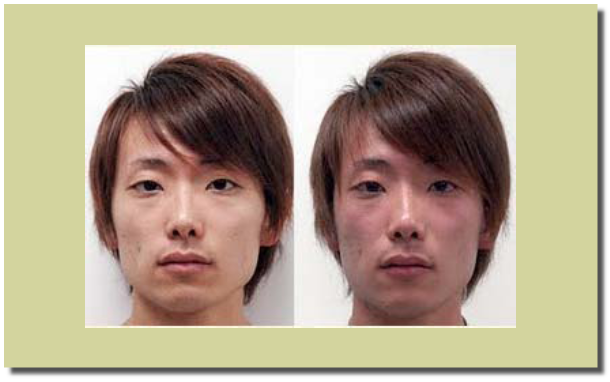 Not a week passes without an enthusiastic article in the wine press on the potential wine market in China. The opportunity to sell American wine to China’s newly affluent consumers is substantial, but there is one hitch that has not been publicized: the Oriental Flushing Syndrome. 25%-50% (the figure is variously reported in the medical literature) of Chinese suffer from the Oriental Flushing Syndrome (Red-Face Syndrome or Asian Glow). Hundreds of millions of Chinese have a mutation in the gene for aldehyde dehydrogenase-2 isoenzyme, ALDH2, needed to metabolize ingested alcohol. This mutation is rare outside of East Asian populations, except in the Polynesian people. Two enzymes in the liver sequentially metabolize ingested alcohol: first, alcohol dehydrogenase (ADH) converts alcohol to acetaldehyde and second, aldehyde dehydrogenase (ALDH) degrades acetaldehyde to carboxylic acids which then leave the liver and are metabolized by muscle and heart tissue in the body. Acetaldehyde is similar to formaldehyde and is very toxic and carcinogenic. Carboxylic acids such as acetic acid are harmless. ALDH2 is crucial to maintaining low blood levels of acetaldehyde during ingestion of alcohol. High levels of acetaldehyde, which can be reached quickly with small amounts of alcohol ingestion in susceptible Chinese, cause facial and body flushing, heart palpitations, reduced blood pressure, nausea, headache, drowsiness, and the symptoms associated with a hangover. Also known as Asian Flush, this is often a source of embarrassment, and coupled with the unpleasantness, deters sufferers from drinking wine. The Chinese with the ALDH2 mutation are at significantly higher risk for esophageal and oropharyngolaryngeal cancers. Acetaldehyde, which has been shown to be carcinogenic in laboratory animals, is produced in saliva when drinking alcohol. The Chinese who are homozygous for the ALDH2 mutation have almost no ALDH activity and are at greatest risk for cancer. Those that are heterozygous have reduced activity, but this group can develop a tolerance to the adverse effects of acetaldehyde making them also at high risk for esophageal or oropharyngolaryngeal cancers. In addition, a large percentage of Chinese smoke cigarettes which compounds the risk. Cigarette smoking increases acetaldehyde levels in saliva and those with ALDH2 deficiency cannot clear salivary acetaldehyde properly. So, although the potential market for wine sales among China’s newly affluent consumers is large, up to half the population who suffer from the Oriental Flushing Syndrome will be unable or unwilling to drink wine. The avoidance of wine for health reasons makes this imperative. |